If you’ve been researching the best hair transplant in Turkey, you’ve probably noticed the same thing everyone does, dozens of clinics, hundreds of promises, and prices that don’t seem to match.
Every month, thousands of people from the US, Canada, UK, Europe, and the Gulf start planning their trip to Istanbul, drawn by skilled surgeons, realistic prices, and consistent results.
But here’s the part most people miss: not all clinics play by the same rules. Some prioritize volume over precision. Others, usually the surgeon-led ones, treat every graft like art. Knowing the difference can save you money, time, and disappointment.
In this guide, we break down everything you need to know about the real 2026 hair transplant costs in Turkey, how to choose the right clinic, what each method (FUE, DHI, Sapphire) actually does, and what recovery feels like month by month.
You’ll also see what verified patient data and global sources like ISHRS, and USHAŞ reveal about why Turkey continues to lead the world in hair restoration.
Whether you’re just exploring options or ready to book your trip, our article gives you honest, data-backed insight to make confident choices, and to understand what makes Turkey’s success more than just reputation.
At a Glance: Hair Transplant in Turkey 2026
Hair transplant in Turkey isn’t just about price, but it’s about experience, precision, and trust. Here’s everything that matters, simplified.
- Turkey remains the global leader in hair transplantation, performing over 500,000 procedures per year, according to ISHRS 2024 data.
- According to USHAS, in 2024, 1.506.442 foreign patients have visited Turkey to get health services. And 733.798 patients in the first 6 months of 2025.
- Average cost (2026): $2,700–$4,500 for 2,500–3,500 grafts, including hotel and transfers.
- Top techniques: FUE, Sapphire FUE, and DHI, each offering 90–95% graft survival when done by ISHRS-certified surgeons.
- Cities to consider: Istanbul (surgeon-led, advanced techniques), Antalya (affordable packages), Ankara (smaller, medical-oriented clinics).
- Safety first: Verify Ministry of Health licenses and ISHRS/EHRS memberships before booking.
- Average stay: 3 days for surgery and follow-up.
- Growth timeline: noticeable results by month 3–6, full density at month 12.
- PRP and exosome therapies improve regrowth by 10–20%.
- Over 90% of patients rate their experience as “excellent,” per USHAŞ and Medihair surveys.
- Why people keep coming: personalized care, clear communication, and surgeons who treat every patient like a long-term project, not a one-day client.
Surgery & Recovery Info
- Procedure Time: 6-8 hours
- Anesthesia Type: Local anesthesia
- Return to Work: within 2-5 days
- Overall Recovery Time: expected within 1 week
- Exercise: advised to wait 2-3 weeks before resuming exercise
- Visible Results: Optimal results are typically seen in 12-15 months
- Success Rate: over 90% in Turkish clinics
Turkey’s strength isn’t just in cost efficiency. It’s in consistency, patient care, and an unmatched ecosystem built to make transformation accessible to everyone.
Why People Choose Hair Transplant in Turkey
Most people still think of hair transplant in Turkey as just an affordable option. But affordability is only part of the story. What truly sets Turkey apart is the scale of expertise that has grown around hair restoration.
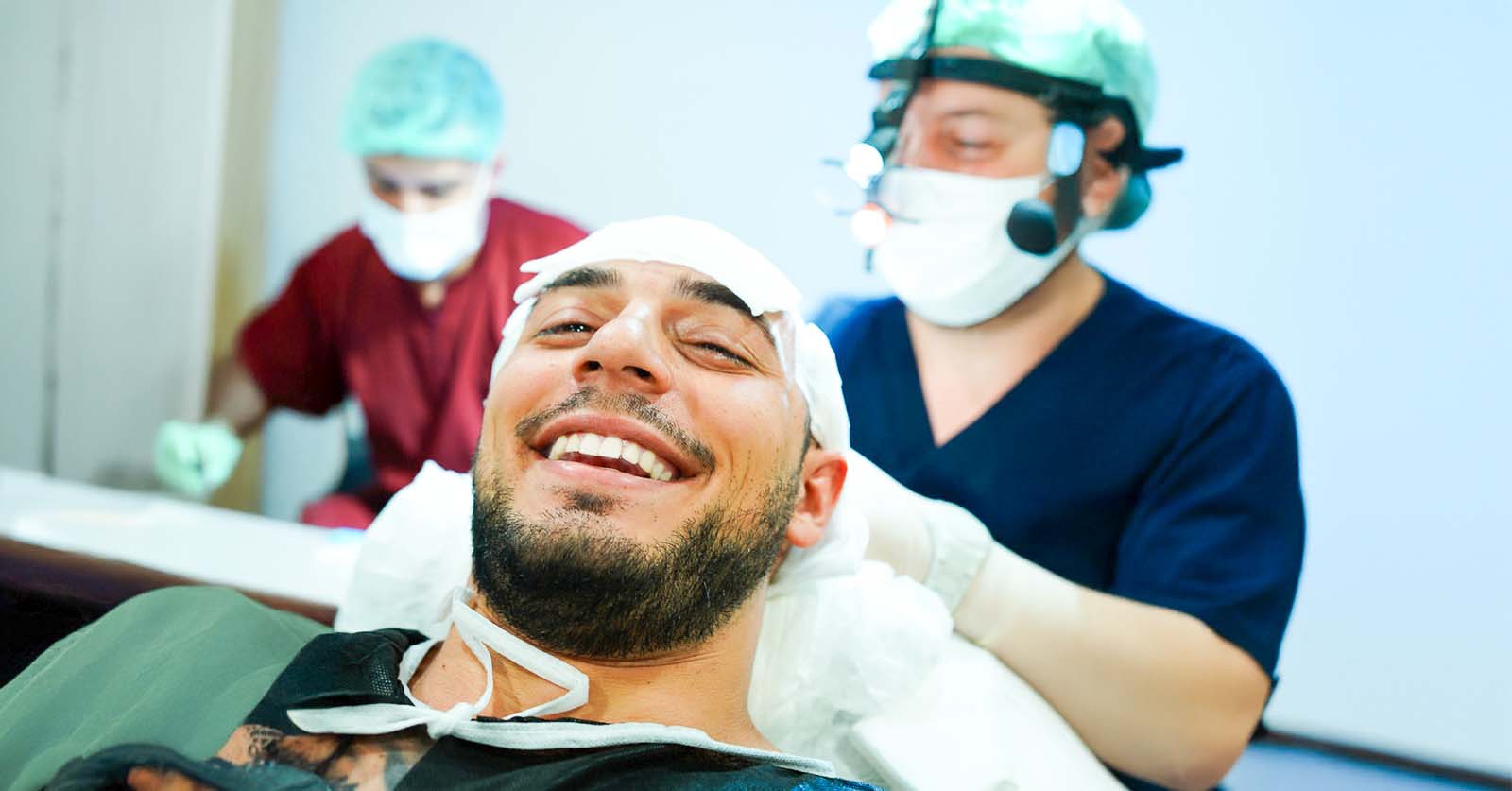
Surgeons here don’t perform a few dozen procedures a year; they handle hundreds. That repetition shapes instinct in every graft angle, incision depth, and density pattern becomes second nature.
According to USHAŞ (International Health Services Inc.), more than 1.5 million patients came to Turkey for healthcare in 2024, generating over 3 billion USD. A large share of those visits were for aesthetic and hair-related procedures.
By mid-2025, another 733 thousand medical travelers had already arrived, and this is a proof that demand isn’t slowing. ISHRS data puts Turkey in the top three countries worldwide for total hair transplants performed.
Majority of the best hair transplant clinics in Turkey operate under the Turkish Ministry of Health, which enforces sterilization and anesthesia protocols that meet European standards. Many surgeons hold memberships in ISHRS or EHRS, signaling ongoing education and peer accountability.
Istanbeautiful team insight: “The clinics that last are the ones obsessed with consistency. Not price tags, not celebrity names, just steady, natural results year after year.”
And there’s something else people mention after surgery: the way they’re treated. From airport pickup to post-op care, the hospitality feels personal. That human factor explains why Medihair and Trustpilot reviews for Turkish hair-restoration clinics average 4.7 out of 5.
Turkey’s edge isn’t a secret formula; it’s repetition, regulation, and real empathy wrapped into one experience.
Insights from surgeons and patient experiences
Talk to any experienced Turkish surgeon and you’ll hear the same thing, that is technique matters, but so does timing and planning. A well-executed FUE or DHI procedure can take eight hours, yet most of the artistry happens long before the first graft is removed.
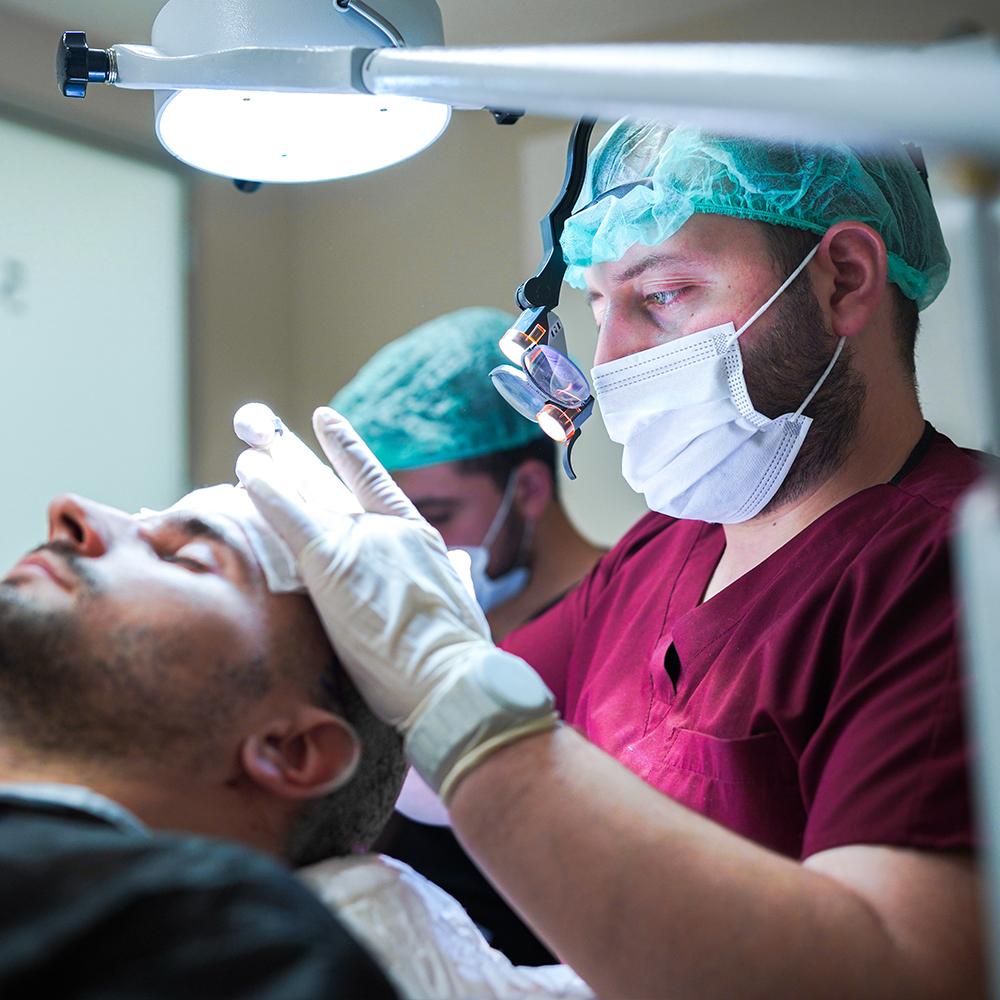
Surgeons emphasize density mapping and donor management, two areas where high-volume practice creates precision. As Dr. Ahmet Murat (MD) from Hermest Hair Transplant Clinic Istanbul explains, “Each patient’s pattern is like a fingerprint. You don’t copy and paste designs; you build them one follicle at a time.”
Patients notice that difference. Many describe recovery as smoother than expected, often flying home within four days. One patient from London told us the hardest part wasn’t the pain as it was realizing how quickly the anxiety disappeared once he met the medical team in person.
That combination of science and reassurance is why people keep coming. In Turkey, the procedure doesn’t feel transactional. It feels like teamwork.
Why Istanbul is so popular?
Istanbul has quietly become the heartbeat of global hair transplantation. Every year, thousands of patients fly in from US, Canada, UK, Europe, the Gulf, and beyond, not just because it’s cheaper, but because the system here actually works. Our city blends medical expertise, accessibility, and care in a way few destinations can match.

Let’s start with the basics. Istanbul’s healthcare system is one of the strongest in the region. Clinics operate inside A+++ private hospitals, equipped with sterile surgical rooms and advanced anesthesia systems regulated by the Turkish Ministry of Health.
Many of Turkey’s most skilled ISHRS-certified surgeons base themselves here, drawn by the city’s reputation and infrastructure.
The logistics make it even easier. Istanbul is directly connected to more than 300 international airports, so patients can fly in, get their surgery, and return home within just a few days.
Most of the best hair transplant clinics in Istanbul handle everything such as airport transfers, hotel stays, and aftercare coordination that make the entire trip smooth from start to finish.
Other Cities Worth Considering
While Istanbul leads the field, it’s not the only option. Cities like Ankara, Antalya, and Izmir have developed strong reputations for quality hair restoration procedures, often in quieter, resort-style settings. Prices are similar, and the medical standards remain high, but Istanbul’s combination of experience, technology, and accessibility still puts it a step ahead.
Istanbeautiful Team Insight
“One of the reasons Turkey remains a top destination is the consistency in results. Clinics in Istanbul have streamlined the process for international patients from airport pickup to follow-up care, while maintaining high medical standards.”
Hair Transplant Cost in Turkey 2026 – What You Actually Pay For
Most people start their research with one question: how much does a hair transplant cost in Turkey? And honestly, it’s the right place to start. Because what you’re paying for isn’t just grafts, but also it’s experience, surgeon time, aftercare, and precision.
Average Hair Transplant Turkey Cost by Method (FUE, DHI, Sapphire FUE)
Based on USHAŞ and Medihair data for 2026, the average FUE hair transplant in Turkey costs between $2,500 and $4,000 for 2,500–3,500 grafts. The DHI technique, which uses a Choi implanter pen for higher density work, ranges from $3,000 to $4,800. For Sapphire FUE, which involves finer blades for cleaner incisions, prices sit around $2,800 to $4,500.
In contrast, the same surgery in the UK or the US often exceeds $10,000–$15,000. Yet the quality gap isn’t what people expect — it’s smaller than ever. Clinics in Istanbul, Ankara, and Antalya now use the same tools, microscopes, and anesthetic systems as their Western counterparts.
According to USHAŞ and the Turkish Health Tourism Association (THTC), hair restoration remains one of Turkey’s top three aesthetic procedures, supported by over 1.5 million international health tourists annually.
Istanbeautiful team insight: “The price difference doesn’t come from cutting corners, it comes from efficiency. Surgeons here perform more procedures in a month than some do in a year abroad.”
Cost per Graft Comparison Between Istanbul, Ankara, and Antalya
If you break it down per graft, Istanbul averages around $0.90–$1.35, Ankara around $0.85–$1.10, and Antalya roughly $0.95–$1.25. Smaller coastal cities sometimes offer slightly lower rates, but the highest patient satisfaction still centers around Istanbul — mostly because of the concentration of surgeon-led clinics and internationally accredited hospitals.
A practical rule of thumb? Anything below $1,500 for a full procedure is usually too good to be true. Clinics offering extreme discounts often rely on technician-only operations or cut post-op care entirely.
Why Turkey Remains Affordable Without Compromising Quality
There’s a simple economic reason Turkey can keep prices low: volume and infrastructure. High demand reduces fixed costs per patient. Most clinics own their facilities, use in-house nursing teams, and source supplies locally that are all regulated under the Ministry of Health.
Currency exchange also plays a part. With the Turkish Lira’s current rate, even premium clinics can maintain competitive international pricing.
But affordability here doesn’t mean risk. ISHRS data shows that Turkish clinics with licensed surgeons report graft survival rates above 90%, matching the global average for top-tier facilities.
And that’s what makes Turkey unusual is that a rare case where price, access, and quality coexist.
Hair Transplant Packages in Turkey – What’s Actually Included
One of the biggest reasons international patients love getting a hair transplant in Turkey is the simplicity. Most clinics don’t just sell a surgery — they sell a complete experience.
Flights, hotels, transfers, and post-op care are organized so smoothly that the medical part almost feels secondary. But not all “all-inclusive” packages mean the same thing, and that’s where most confusion begins.
Typical Inclusions: Accommodation, Transfers, and PRP Therapy
A standard hair transplant package in Istanbul usually includes:
- Airport pickup and return transfers
- Two or three nights at a partner hotel (often 4-star or boutique)
- Blood tests, local anesthesia, and surgery fees
- PRP (Platelet-Rich Plasma) therapy
- Post-op washing session and medications
- Translation and coordination support
According to Medihair and USHAŞ, more than 70% of patients book packages because they remove logistical stress. Some clinics even go further — offering VIP transfers, personal assistants, or recovery suites within the same building.
Istanbeautiful team insight: “Good clinics don’t overload you with luxury. They make the process seamless. the driver is on time, the nurse knows your name, and your aftercare feels personal.”
This model, which started in Istanbul around 2010, has since spread to Ankara and Antalya, making medical tourism in Turkey one of the world’s most organized systems.
Hidden Costs and What to Ask Before Booking
Not every package tells the full story upfront. Some clinics list an appealing flat rate but exclude medications, PRP boosters, or hotel upgrades. Others may charge extra for dense packing, beard grafts, or a second PRP session.
Before confirming, always ask:
- Is the quoted price per graft or all-inclusive?
- Does the surgeon personally perform extractions and incisions?
- How many PRP or aftercare sessions are included?
- What happens if the surgery requires more grafts than estimated?
According to Forbes Health, transparent hair clinics in Turkey outperform others in patient satisfaction by 28%. This is not because of price, but because expectations are clear from the start.
We can say that a good hair transplant package should feel like a promise, not a puzzle. When done right, it lets you focus on recovery instead of logistics.
Before You Book – Who Is (and Isn’t) a Good Candidate
Not everyone who wants a hair transplant in Turkey should get one, at least, not immediately. The truth is, candidacy depends on more than just how much hair you’ve lost. It’s about scalp health, donor density, medical history, and expectations.
The best hair clinics in Istanbul spend as much time evaluating suitability as they do performing the surgery itself.
Ideal Age and Medical Profile for Hair Transplant Success
Most surgeons agree the ideal age range is between 25 and 55. Before 25, hair loss patterns often haven’t stabilized, which can lead to chasing receding areas with multiple surgeries later. After 55, the scalp’s healing response slows, and donor density may be limited.
Strong candidates usually:
- Have a stable hair loss pattern (diagnosed as Norwood 3–6)
- Possess good donor density (typically above 60 grafts/cm²)
- Are in good general health (no uncontrolled diabetes, heart, or autoimmune conditions)
As Dr. Gökay Bilgin from Smile Hair Clinic Istanbul explains, “We don’t just look at hair loss. We study the skin, blood flow, and hormonal balance. A perfect surgery on the wrong candidate still fails.”
Conditions That May Affect Graft Survival or Healing
Certain factors can reduce graft survival or slow recovery:
- Thyroid disorders, iron deficiency, or autoimmune diseases
- Smoking and heavy alcohol use (both limit oxygen delivery to follicles)
- Prior scar tissue from older surgeries
- Active scalp infections or dermatitis
A 2024 study published in the Aesthetic Surgery Journal found that patients who quit smoking at least two weeks before surgery had 15% higher graft survival rates compared to smokers.
Istanbeautiful team insight: “If your clinic skips the medical questionnaire or rushes through bloodwork, walk away. Screening isn’t bureaucracy, it’s protection.”
Pre-Surgery Screening and Consultation Tips
Before booking, schedule a proper video consultation or in-person evaluation. Bring your medical history, current medications, and recent lab results. Ask your surgeon to analyze both donor and recipient areas under magnification.
Reliable clinics follow ISHRS guidelines for preoperative evaluation and perform blood tests for hemoglobin, liver enzymes, and viral markers. They’ll also discuss realistic coverage limits — not everyone can get a “full head” in one session.
The takeaway? A good candidate isn’t just someone who wants new hair — it’s someone whose body and lifestyle are ready for it.
How to Choose the Best Hair Transplant Clinic in Turkey (Without Regrets)
It’s easy to get lost in the sea of glossy clinic ads. Every website promises “natural results” and “affordable packages.” But finding the best hair transplant clinic in Turkey isn’t about chasing five-star photos — it’s about understanding who’s actually performing the surgery and how the clinic operates behind the scenes.
Verifying ISHRS and Ministry of Health Certifications
A real clinic doesn’t hide its medical credentials. Start by checking whether the surgeon is registered with the International Society of Hair Restoration Surgery (ISHRS) or the European Hair Restoration Society (EHRS). Both organizations publish public member lists online.
Next, look for the clinic’s Ministry of Health license number, usually displayed on their website or office wall. This ensures compliance with sterilization, anesthesia safety, and patient data regulations.
According to USHAŞ, over 1,200 licensed facilities currently perform hair restoration procedures in Turkey, but only about 35% have surgeon-led teams.
Reputable clinics will also provide documentation on their surgical assistants and anesthesia team. If they hesitate or redirect you to a “coordinator” instead of a physician — that’s a sign to keep searching.
Surgeon-Led vs Technician-Led Procedures
Here’s the truth few clinics advertise: in many centers, technicians perform most of the operation while the surgeon appears briefly for incisions. While this isn’t illegal, it often affects consistency and precision. Medihair’s patient audit found a 22% higher graft survival rate when the surgeon performed both the incision and implantation steps.
As Dr. Gökhan Bilgin puts it, “The hand holding the implanter determines everything — from graft angle to density flow. It’s not just skill, it’s rhythm.”
If your clinic mentions “team surgery” or “assisted operation,” ask exactly what that means. In the best clinics, technicians assist; they don’t lead.
Red Flags to Avoid When Booking Online
- No verifiable surgeon name on the website
- Price-first communication (“We can do 5,000 grafts for $1,000!”)
- Stock photos instead of real before-after cases
- No pre-op video consultation option
Istanbeautiful team insight: “A serious clinic makes you feel informed, not rushed. You’ll sense it within the first five minutes of the call.”
3 Must-Ask Questions Before You Commit
- Who performs the incisions and implantations?
- How many procedures does the surgeon personally do per day?
- Can I speak to a past international patient (not just see photos)?
The clinics that answer confidently are the ones worth trusting. The ones that avoid details, they’re the ones people message us about later with regret.
Top Hair Transplant Clinics in Istanbul Turkey
Our team personally visited Istanbul’s leading hair transplant centers, observing their surgical techniques, patient approach, and overall treatment quality up close. For a detailed breakdown of each clinic, please visit our full guide: 10 Best Hair Transplant Clinics in Istanbul Turkey: Our Review
Hermest Hair Transplant Clinic (Dr. Ahmet Murat)
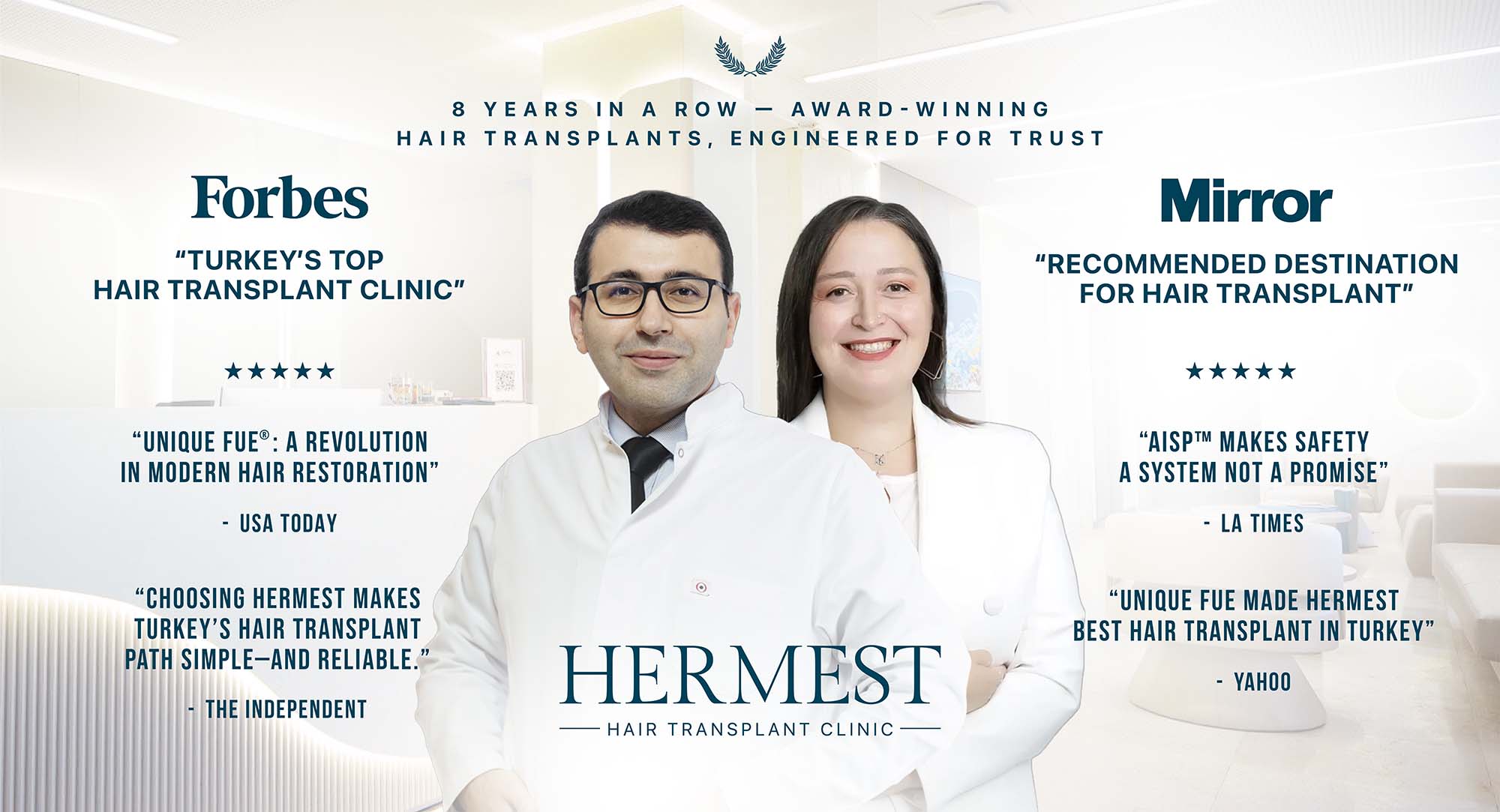
- Website: hermestclinic.com
- Techniques Offered: UNIQUE FUE®, Sapphire FUE, DHI
- Accreditations: ISHRS, Ministry of Health, THTC-compliant
- Experience: Over 10 years, 12,000+ transplants
- Rating: 4.9 based on 950+ Google reviews
- Price Range: $2,500–$4,000
Ask any doctor in Istanbul’s aesthetic community about the best hair transplant clinics in Turkey, and Hermest almost always gets mentioned. Based in Kadıköy, the clinic is led by Dr. Ahmet Murat, known for his precision-driven UNIQUE FUE® technique, a method refined to boost graft survival and achieve denser, natural-looking hairlines.
Every detail, from hairline planning to incision work, is handled personally by Dr. Murat, a rarity in a market where technician-led procedures are common. Backed by an average 98% graft survival rate and performed in an A+ class hospital, Hermest blends surgical science with careful artistry.
The clinic follows ISHRS and Turkish Ministry of Health standards, offering full packages that include PRP care, VIP transfers, and hotel stays.
Istanbeautiful Team Insight:
“At Hermest, precision isn’t a slogan, it’s daily routine. Watching Dr. Murat review graft angles himself says everything about why their results look so natural.”
Note: Please fill out the form at the bottom of the page to reach Hermest Clinic to get a quote and consultation, plus special discount.

Smile Hair Clinic (Dr. Mehmet Erdoğan & Dr. Gökay Bilgin)
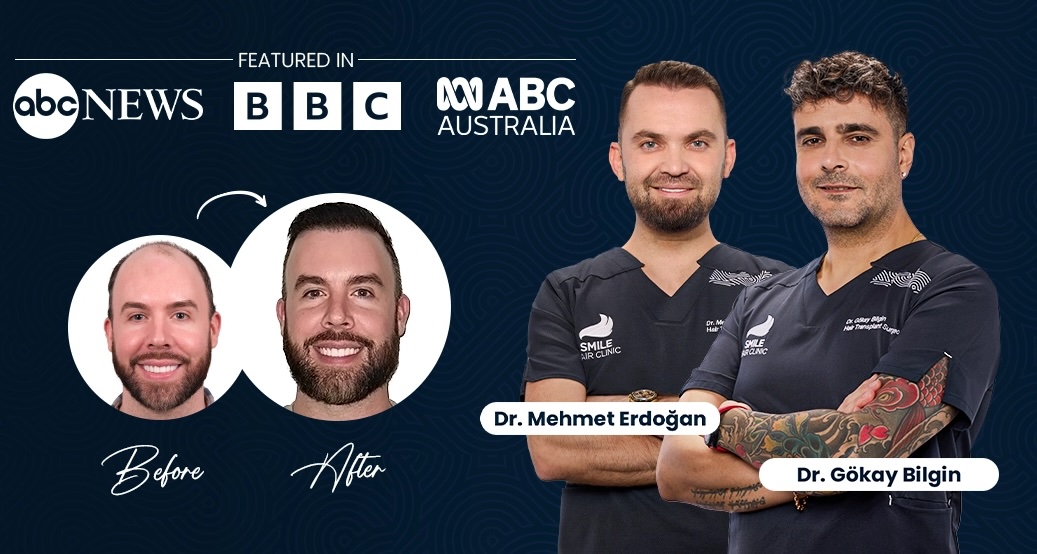
- Website: smilehairclinic.com
- Techniques Offered: FUE, DHI, Sapphire FUE
- Accreditations: ISHRS, EHRS, Ministry of Health (License)
- Experience: Over 10 years, 10,000+ transplants
- Rating: 4.9 based on 2000+ Google reviews
- Price Range: $3,500–$4,200
Founded by Dr. Mehmet Erdoğan and Dr. Gökay Bilgin, Smile Hair Clinic is one of Istanbul’s most internationally recognized hair transplant centers. Known for its True™ Philosophy, the clinic treats hair restoration as a full transformation, not just a procedure. Every patient undergoes personalized planning, precise hairline design, and surgeon-led implantation.
The clinic performs both FUE and DHI techniques using advanced imaging systems to achieve balanced, natural results. Its modern facility in Ataşehir combines medical expertise with hotel-like comfort, attracting patients from over 80 countries.
Istanbeautiful Team Insight:
“Dr. Erdoğan and Dr. Bilgin bring a calm precision to their work. What stands out most is how personal the process feels, no rushed consultations, no copy-paste hairlines. Just meticulous care from start to finish.”
Note: Please fill out the form at the bottom of the page to reach Smile Clinic to get a quote and consultation, plus special discount.

HairNeva Hair Transplant Clinic (Dr. Güncel Öztürk)
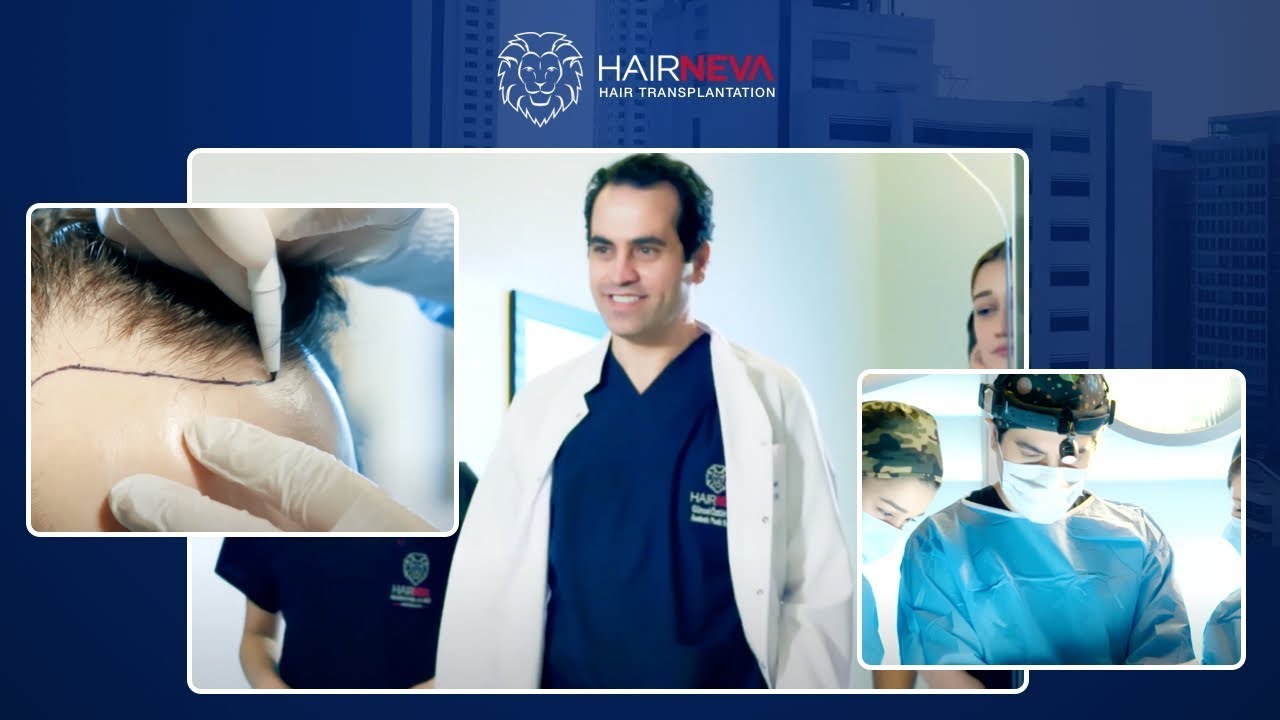
- Website: hairneva.com
- Techniques Offered: Sapphire FUE, DHI, PRP-assisted transplants
- Accreditations: Ministry of Health, EHRS
- Experience: Over 12,000 successful procedures
- Rating: 4.9 based on 750+ Google reviews
- Price Range: $3,250–$4,300
Led by Assoc. Prof. Dr. Güncel Öztürk, a board-certified plastic surgeon with EBOPRAS accreditation, HairNeva blends medical science with artistic sensibility. Each procedure performed at Fulya Acıbadem Hospital that follows strict medical protocols while maintaining a boutique, patient-first approach.
The clinic is known for its ethically transparent process, personalized planning, and long-term aftercare. International patients praise HairNeva for the confidence and calm it brings to an otherwise technical journey.
Istanbeautiful Team Insight:
“HairNeva feels less like a clinic and more like a studio, where every detail is intentional. Dr. Öztürk’s background in art and reconstructive surgery clearly shapes his aesthetic precision.”
Note: Please fill out the form at the bottom of the page to reach HairNeva to get a quote and consultation, plus special discount.

Sapphire Hair Clinic (Spec. Dr. Dilek Çay)

- Website: sapphirehairclinic.com
- Techniques Offered: Sapphire FUE, DHI
- Accreditations: Ministry of Health
- Experience: Over 10 years
- Price Range: $2,000–$3,500
Located in Şişli, Sapphire Hair Clinic offers hair transplants that combine modern techniques with holistic care. Under Spec. Dr. Dilek Çay’s guidance, the clinic provides FUE, DHI, and Sapphire FUE procedures supported by an in-house anesthesiology team for maximum comfort and safety. Each treatment plan is personalized, focusing on natural density and patient well-being rather than volume alone.
Beyond surgery, patients enjoy seamless support, with airport transfers, hotel stays, and post-op care all handled by the clinic’s dedicated coordinators.
Istanbeautiful Team Insight:
“We noticed how calm the atmosphere is at Sapphire. Dr. Çay personally greets patients before surgery, a small gesture, but one that makes the entire experience feel human.”
Note: Please fill out the form at the bottom of the page to reach Sapphire Clinic to get a quote and consultation, plus special discount.

Dr. Terziler Exclusive Clinic (Dr. Servet Terziler)
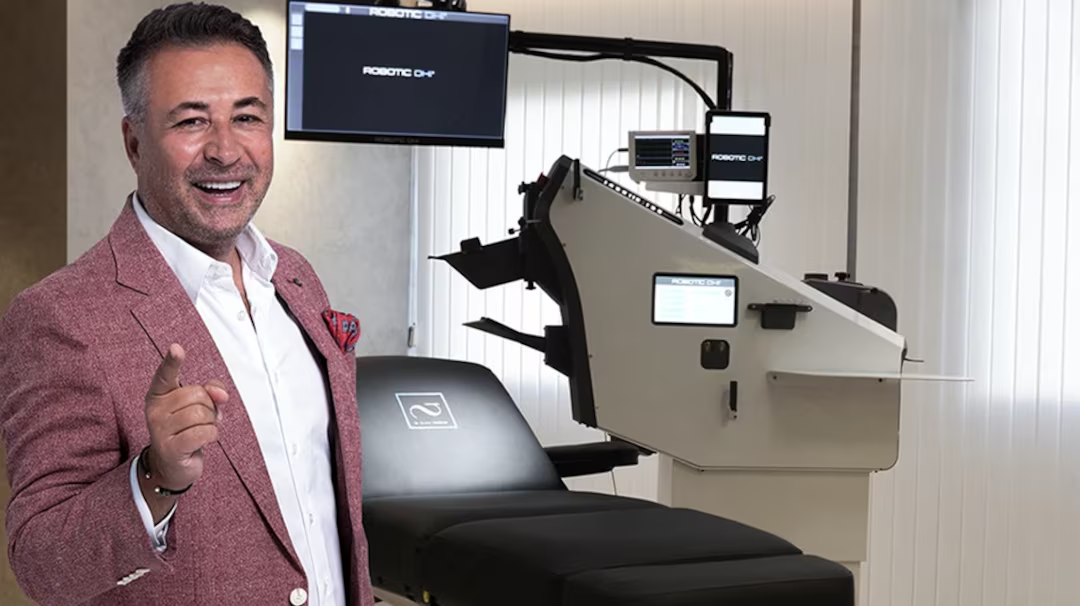
- Website: drterziler.com
- Techniques Offered: Picasso Robotic DHI, Robotic DHI, and Sapphire FUE
- Accreditations: Ministry of Health
- Experience: Over 30 years
- Price Range: $3,000–$4,500
Known as the “Picasso of Hair”, Dr. Servet Terziler brings over 35 years of experience and a true artistic touch to his work. His Robotic DHI and Sapphire FUE techniques redefine precision, creating hairlines that look as natural as they feel. The clinic’s luxury suites in Etiler reflect its philosophy, comfort, privacy, and innovation working hand in hand.
Patients benefit from advanced technology, regenerative stem cell treatments, and meticulous post-op follow-up designed around individual needs.
Istanbeautiful Team Insight:
“Dr. Terziler’s clinic feels more like an art gallery than a medical space, elegant, quiet, and full of confidence. Watching the team operate like a synchronized orchestra was impressive.”
Note: Please fill out the form at the bottom of the page to reach Dr Terziler Clinic to get a quote and consultation, plus special discount.

MedArt Hair (Dr. Ömer Aykut Sumer)
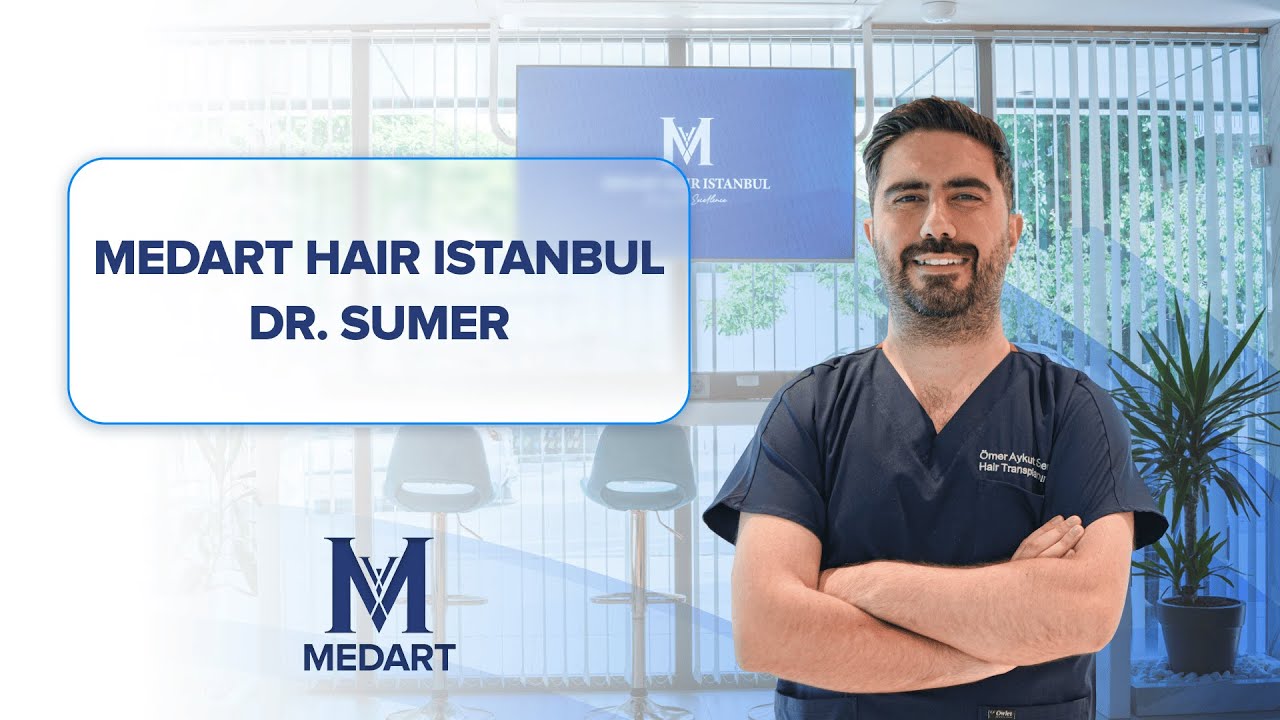
- Website: medartinternational.com
- Techniques Offered: DHI, FUE and Sapphire FUE
- Accreditations: Ministry of Health
- Experience: Over 10 years
- Rating: 5.0 based on 300+ Google reviews
- Price Range: $3,000–$4,000
With its base in London’s Harley Street and operations in Istanbul, MedArt Hair connects global standards with Turkish expertise. Dr. Ömer Aykut Sümer, a GMC-registered surgeon, leads the clinic’s procedures, focusing on FUE, DHI, and Stem Cell Hair Transplant techniques. Each treatment is designed around transparency and comfort, with no assembly-line operations, just one patient at a time.
MedArt’s boutique model offers concierge-level care, from consultations to aftercare, ensuring patients feel informed and cared for at every stage.
Istanbeautiful Team Insight:
“MedArt feels distinctly international. Dr. Sümer’s calm communication style and science-based approach make it ideal for UK patients seeking quality without confusion.”
Note: Please fill out the form at the bottom of the page to reach MedArt Hair Clinic to get a quote and consultation, plus special discount.

Aslı Tarcan Clinic
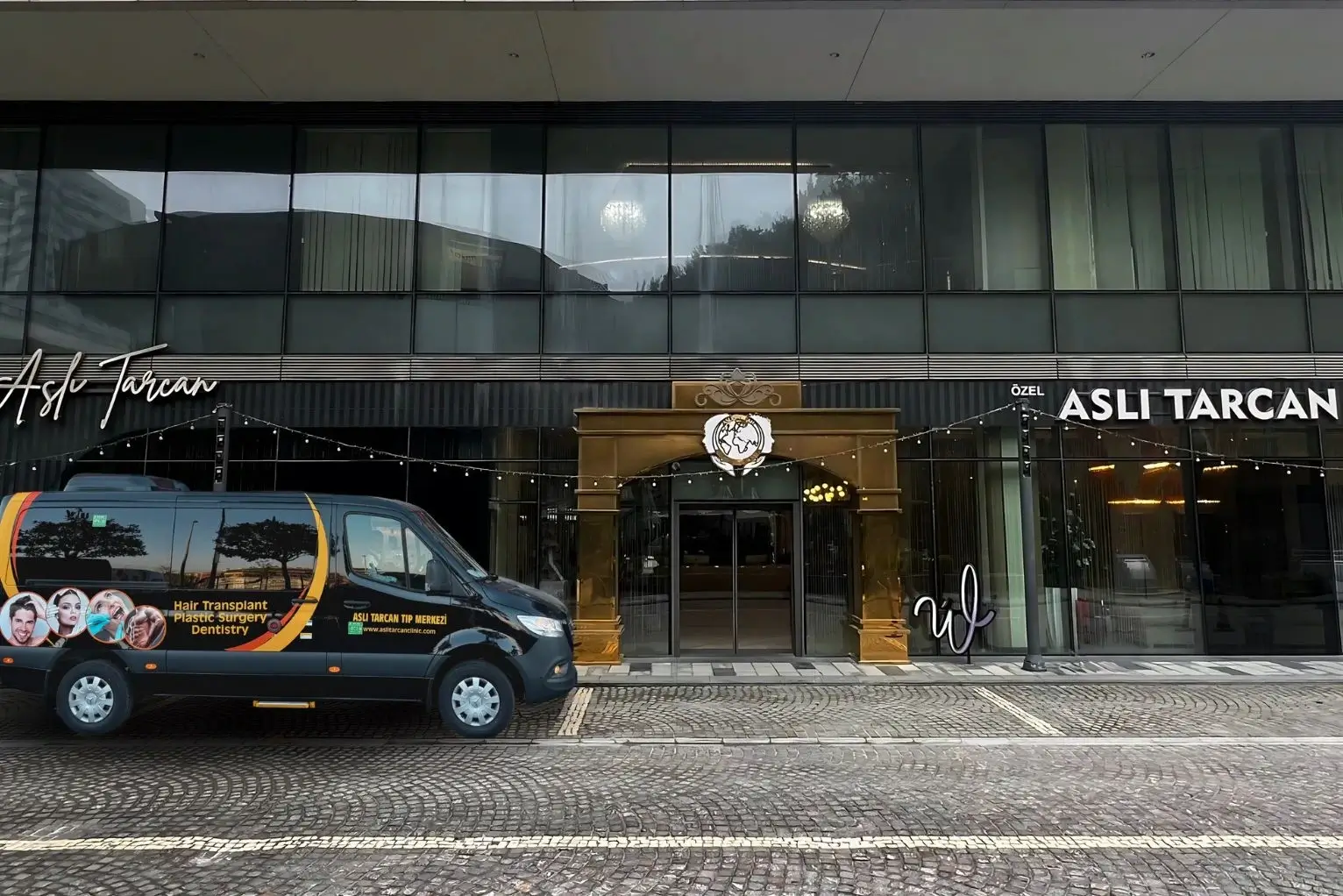
- Website: aslitarcanglobal.com
- Techniques Offered: DHI, FUE and Sapphire FUE
- Accreditations: Ministry of Health (License)
- Experience: Over 20 years
- Rating: 4.8 based on 2300+ Google reviews
- Price Range: $2,500–$3,500
Founded by Aslı Tarcan, one of Turkey’s leading health and aesthetics experts, this clinic blends 20+ years of experience with a welcoming, patient-focused atmosphere. Offering FUE, DHI, Sapphire FUE, and Robotic DHI, the clinic emphasizes natural results, hygiene, and patient education. Every treatment is explained step by step, ensuring visitors, especially international ones feel confident and cared for.
The clinic also provides complete travel support, including hotel accommodation, airport transfers, and translation assistance. It’s particularly known for its expertise in Afro-textured hair transplants, a field requiring technical precision and tailored techniques.
Istanbeautiful Team Insight:
“Aslı Tarcan’s team impressed us with how approachable and transparent they are. Nothing feels rushed or unclear, every patient knows exactly what’s happening and why.”
Note: Please fill out the form at the bottom of the page to reach Aslı Tarcan Clinic to get a quote and consultation, plus special discount.

HEVA Clinic
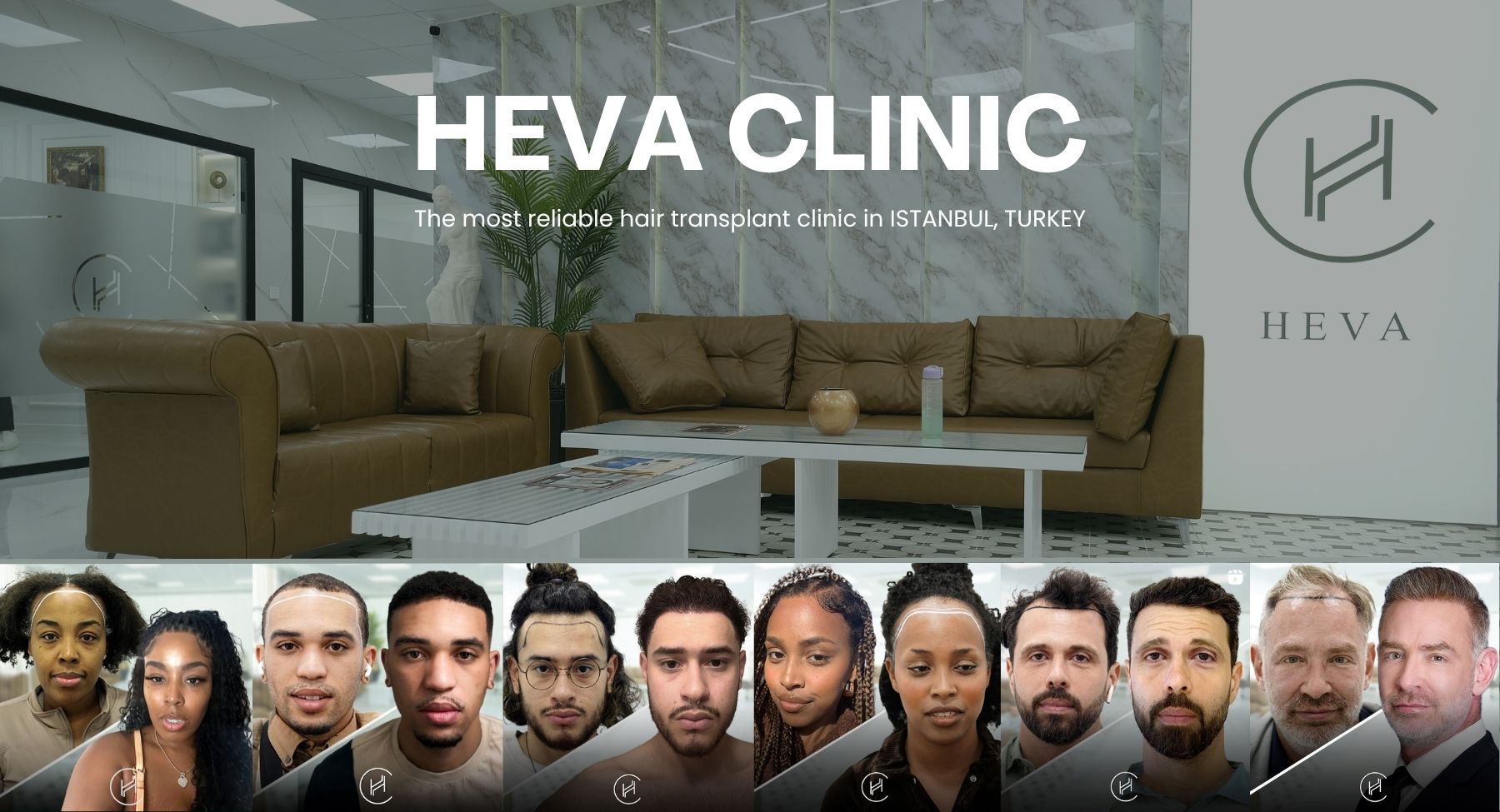
- Website: dentalhairclinicturkey.com
- Techniques Offered: FUE, Sapphire FUE, DHI, Afro Hair Transplant
- Accreditations: ISHRS, JCI Hospital, Ministry of Health (License)
- Experience: Over a decade of medical excellence
- Rating: 4.9 based on 1750+ Google reviews
- Price Range: $2,600–$4,500
Located in a modern seven-floor facility in Istanbul, Heva Clinic has become a trusted name in both hair restoration and dental aesthetics. Led by an ISHRS-affiliated medical director, the team is skilled in all hair types from straight to Afro-textured, using advanced FUE, DHI, and Sapphire techniques.
Their approach blends personalized planning, private treatment rooms, and patient comfort, complete with a relaxing lounge and even barista-made coffee. The Heva Mobile App extends aftercare worldwide, helping patients stay connected with their medical team long after returning home.
Istanbeautiful Team Insight:
“Heva feels more like a five-star medical retreat than a clinic. Their combination of medical precision and genuine hospitality left a strong impression, calm, transparent, and refreshingly human.”
Note: Please fill out the form at the bottom of the page to reach HEVA Clinic to get a quote and consultation, plus special discount.

Yaman Surgery Center (Dr. Resul Yaman)
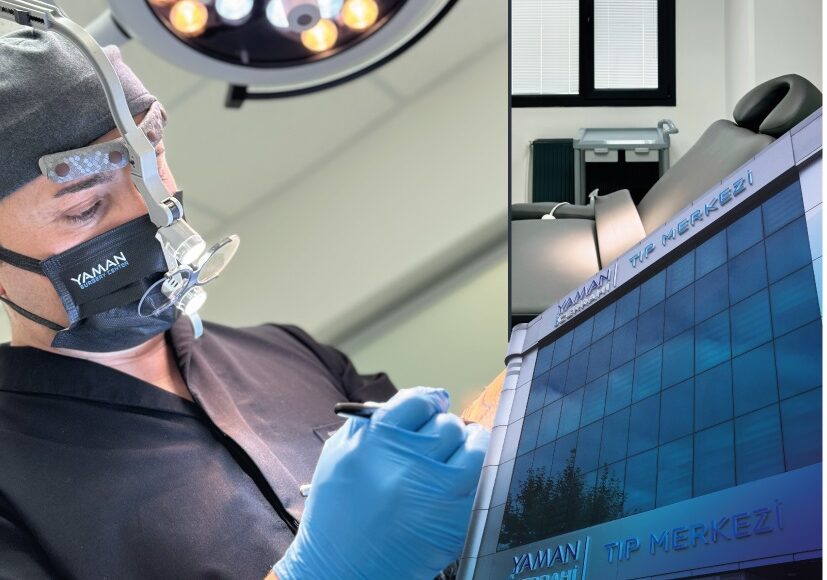
- Website: resulyaman.com
- Techniques Offered: FUE, Sapphire FUE, DHI
- Accreditations: Ministry of Health
- Experience: Over 20 years
- Rating: 4.6 based on 50+ Google reviews
- Price Range: $3,750–$6,000
Dr. Resul Yaman has spent over 15 years refining hair transplantation into a surgeon-led craft. At his Istanbul clinic, he performs FUE and DHI using only single-use tools, ensuring safety and hygiene at the highest level. What makes Dr. Yaman stand out is his hands-on approach, he personally handles the incision phase and closely follows each patient’s healing progress.
The clinic’s transparent pricing and small daily patient volume reflect its quality-over-quantity mindset.
Istanbeautiful Team Insight:
“We appreciated how involved Dr. Yaman is, that he doesn’t delegate critical parts of surgery. Watching him map out graft angles himself explained why so many of his patients call their results ‘life-changing.’”
Note: Please fill out the form at the bottom of the page to reach Dr. Yaman Clinic to get a quote and consultation, plus special discount.

Soraca Med

- Location: Antalya and Istanbul, Turkey
- Rating: 5 based on 55+ Google reviews
- Price Range: $2,350–$4,000
Soraca Med is a newer name with a refreshing attitude. Their team focuses on building genuine connections with each patient, offering tailored packages that include hotel stays and transfers. With clinics in both Istanbul and Antalya, Soraca Med attracts travelers who prefer smaller, boutique experiences without sacrificing professionalism.
Istanbeautiful Insight: “It’s not about volume here — it’s about presence. You feel cared for the moment you walk in.”
Note: Please fill out the form at the bottom of the page to reach Soraca Med to get a quote and consultation, plus special discount.

About FUE, DHI & Sapphire Techniques
If you’ve started researching hair transplant in Turkey, you’ve probably seen these three letters everywhere: FUE, DHI, and Sapphire.
They’re often used like marketing buzzwords, but behind them are very real technical differences that shape your final result. Knowing which one fits your situation is what separates a good decision from an expensive disappointment.
FUE Hair Transplant – Standard, Sapphire, and Manual Variants
FUE (Follicular Unit Extraction) is the backbone of modern hair restoration in Turkey. Instead of removing a strip of skin, the surgeon extracts tiny follicular units one by one using micro-punch tools.

It leaves no linear scar and allows faster healing — usually within seven to ten days. This makes Turkey one of the top destinations for the best FUE hair transplants.

Standard FUE uses steel blades for incisions, while Sapphire FUE replaces them with ultra-sharp sapphire-tipped blades. This small change reduces tissue trauma, creating smaller channels and allowing denser graft placement.
Clinics such as Hermest Hair Clinic, Smile Hair Clinic and Hair Neva Clinic in Istanbul have made Sapphire FUE their main technique, citing better graft survival rates and less post-op swelling.
Manual FUE, though less common, gives the surgeon full control over angle and depth but takes longer and costs slightly more. It’s typically preferred for smaller, high-precision areas like hairlines or temples.
DHI Technique and How It Differs from FUE
DHI (Direct Hair Implantation) skips the step of opening channels altogether. Instead, grafts are implanted directly using a Choi implanter pen, which controls depth and angle automatically. It’s ideal for refining hairlines or filling small patches without shaving the entire head.

Because it requires more focus and time, DHI hair transplant in Turkey often costs about 15–25% more than FUE. However, it’s also linked to shorter recovery times and a slightly higher density potential in smaller areas.
According to Aesthetic Surgery Journal, graft survival between DHI and FUE is statistically similar — around 92–95%, provided the surgeon, not the technician, handles both extraction and implantation.
Micro Sapphire DHI
A combination of Sapphire FUE channel opening and DHI implantation — this hybrid technique is offered in high-end clinics and provides excellent density and natural appearance.
Unshaven Hair Transplant Turkey
An option for patients who want discretion. Clinics can perform FUE or DHI without shaving the entire head — ideal for celebrities, professionals, or anyone concerned about social downtime.
Afro Hair Transplant in Turkey
Specialized techniques are used for Afro-textured hair due to its curl pattern and skin characteristics. The procedure can be done only in the hands of experienced surgeons.
Beard Transplant in Turkey
Turkey is not only a leading destination for scalp hair restoration — it’s also become one of the top countries for beard transplants, attracting men from Europe, the Middle East, and North America who want to fill patchy facial hair or grow a full beard.
Which Method Is Best for Your Hairline or Density Goals
If your goal is full coverage, FUE (standard or Sapphire) remains the most efficient. For dense, natural frontlines, DHI offers precision and minimal trauma. Some top clinics now use hybrid approaches — combining FUE for the crown and DHI for the frontal zone.
Istanbeautiful team insight: “Patients often ask which method gives the ‘best result.’ The truth? The best method is the one your surgeon has mastered, not the one trending online.”
Choosing between them isn’t about buzzwords — it’s about matching technique to your pattern, donor area, and expectations. That’s what great surgeons in Turkey do best.
FUE vs DHI Hair Transplant in Turkey: Quick Comparison
| Feature | FUE (Follicular Unit Extraction) | DHI (Direct Hair Implantation) |
|---|---|---|
| Technique | Hair follicles are extracted individually and implanted into pre-made microchannels | Hair follicles are implanted directly using a CHOI implanter pen without channel creation |
| Precision Level | High, but slightly less than DHI | Very high — each graft placed with exact angle and depth |
| Speed | Faster — covers large bald areas efficiently | Slower — ideal for smaller, detailed areas |
| Best For | Full scalp restoration, large zones, high graft counts (3,000–5,000+) | Hairline refinement, crown correction, or filling small gaps |
| Surgery Duration | 5–7 hours (depending on graft number) | 6–9 hours (more detailed work) |
| Healing Time | Around 7–10 days | Slightly shorter (5–7 days) |
| Cost in Turkey | $2,000–$3,500 average | $2,800–$4,500 average |
| Scarring | Minimal micro-dots in donor area | Practically invisible — no channels opened |
| Anesthesia Type | Local anesthesia or sedation | Local anesthesia or sedation |
| Density Control | Good for overall balance | Excellent for precise, high-density results |
| Surgeon Involvement | Required during extraction and incision | Required throughout extraction and implantation |
| Ideal Candidate | Patients needing broader coverage | Patients seeking ultra-natural density and design |
| Popular Turkish Clinics | Hermest, Smile Hair, Dr. Cinik, ASMED | HairNeva, Smile Hair, Hermest |
| Longevity of Results | Permanent | Permanent |
Istanbeautiful Tip:
“In real practice, many Istanbul clinics combine both FUE for coverage and DHI for detail. The right balance depends on your donor strength and design goals.”
Per-Graft Pricing, Packages & Break-Even Math
Here’s something most people don’t realize when comparing hair transplant costs in Turkey: the number that matters most isn’t the package total — it’s the price per graft and what’s included in that number. Once you understand that math, you’ll see why some “cheap deals” turn expensive in the long run.
Real Examples: 2,500–3,500 Graft Scenarios
Let’s take a real-world example from data shared by USHAŞ and Medihair.
A 3,000-graft FUE procedure in Istanbul usually costs around $2,700–$3,500, depending on surgeon involvement and technique.
A DHI procedure with the same graft count typically ranges from $3,200–$4,800.
If you switch to Sapphire FUE, it might climb slightly to $3,000–$4,500.
Now, compare that with Western Europe or the United States, where a similar case can easily hit $10,000–$15,000. That’s a 60–70% cost difference — not because Turkish clinics cut corners, but because they handle larger patient volumes and lower operational costs.
According to USHAŞ, Turkey’s health tourism industry surpassed $3 billion in revenue in 2024, much of it driven by cosmetic and hair restoration services.
Istanbeautiful team insight: “Think of it like flying economy versus business class. Both get you there, but comfort and care change everything. The trick is finding clinics that deliver first-class precision at economy pricing.”
Cost Differences Between Methods (FUE vs DHI)
The biggest cost driver isn’t geography — it’s the technique and surgeon time. FUE is efficient and ideal for broad coverage. DHI requires more hands-on time per graft because each follicle is loaded into an implanter pen and inserted one by one.
Most reputable clinics charge 15–25% more for DHI, not as a marketing trick but to reflect that difference in labor intensity and equipment. A surgeon performing both steps personally will typically manage no more than 2,500 grafts per day to maintain quality.
How Exchange Rates Affect Overall Price
The favorable Turkish Lira exchange rate is another reason the same surgery can cost a fraction of European prices. Even premium clinics with ISHRS-certified surgeons can remain affordable for international patients because their overheads — rent, labor, and utilities — are priced in local currency.
That’s why medical tourists continue to flock here even as airfare rises. The total package (including hotel, transfers, and surgery) still lands well below what they’d pay at home.
When you break down the numbers honestly, the math behind hair transplant Turkey cost per graft makes perfect sense — it’s not a loophole. It’s a well-optimized system built on scale, regulation, and skill.
Turkey vs Other Countries – Cost, Quality & Experience
If you’ve compared hair transplant in Turkey with clinics in the UK, Europe, or the US, you’ve probably noticed something surprising: the results look almost identical, but the price difference is enormous. The question is why — and what patients actually gain (or lose) by crossing borders for surgery.
Turkey vs UK and Europe – Cost per Graft Comparison
Across Europe, the average hair transplant cost per graft ranges from €2.50 to €5.00, depending on the clinic and city. In Turkey, it’s typically $0.90 to $1.30, even at top-tier centers. That’s not a typo — the gap can reach 70–80%.
According to Forbes Health, the difference isn’t about quality but economics: lower operational costs, favorable currency rates, and a high volume of international patients allow Turkish clinics to maintain lower prices while offering competitive outcomes.
In addition, clinics in Istanbul, Ankara, and Antalya operate under the Turkish Ministry of Health’s licensing framework, ensuring sterilization and procedural safety at EU-level standards. Patients flying from the UK or Germany frequently note that consultation and aftercare in Turkey feel more personal and accessible than back home.
Istanbeautiful team insight: “The best part about coming to Turkey isn’t just the price. It’s the feeling that you’re being looked after, even days after you’ve left the clinic.”
Turkey vs USA and Canada – Patient Satisfaction and Travel Convenience
In the US, hair restoration can cost $10,000 to $20,000, with many patients facing long wait times for consultations. In Turkey, the same procedures are often scheduled within a week of inquiry. The quick turnaround and bundled packages (including hotel and transfers) reduce friction for travelers.
A 2025 Medihair survey found that 87% of international patients rated their Turkish hair transplant experience as “excellent” or “very good.” By comparison, satisfaction rates for domestic surgeries in North America hovered around 74%, largely due to post-op communication and costs.
Why Turkey’s High Volume Improves Technique Consistency
Here’s the quiet advantage few mention: repetition builds mastery. Turkish surgeons perform hundreds of FUE and DHI procedures annually — sometimes five times the volume of their Western counterparts. That repetition refines everything from graft placement to anesthesia control.
According to ISHRS 2024 Census, Turkey ranks among the top three countries worldwide for total hair restoration procedures, alongside the US and India. This isn’t just about numbers — it’s about the ecosystem. The country has built entire infrastructures around patient flow, hotel partnerships, and aftercare logistics.
So when people say “Turkey is the capital of hair transplants,” it’s not just hype — it’s a measurable outcome of scale, skill, and patient trust.
Risks, Side Effects & How Turkish Clinics Handle Them
Every surgical procedure — even one as refined as a hair transplant in Turkey — comes with potential side effects. The key isn’t avoiding them entirely; it’s choosing a clinic that knows how to manage them properly. The best centers don’t just plan your surgery; they plan your healing.
Common Short-Term Reactions: Swelling, Scabbing, Redness
Most patients experience mild swelling around the forehead or eyes for the first 48–72 hours. Tiny scabs form around each graft site and typically fall off within 7–10 days. Redness can linger for up to three weeks, especially in lighter skin tones — but that’s normal tissue recovery, not infection.
Clinics usually provide:
- Sterile saline spray for hydration
- Antibiotic ointments for donor areas
- Ice packs and mild anti-inflammatories for swelling
According to Healthline, more than 95% of patients experience only these mild, short-lived reactions when proper post-op care is followed.
Istanbeautiful team insight: “If your clinic doesn’t send you home with written aftercare instructions and phone support, that’s a red flag. The best results come from clinics that keep guiding you long after the surgery ends.”
How Reputable Clinics Minimize Infection Risks
Licensed clinics operate under the Turkish Ministry of Health’s sterilization regulations. Single-use instruments are standard, and anesthesia is administered by certified medical staff — not technicians. Many hospitals also use HEPA-filtered surgical rooms to reduce airborne contaminants.
A study published in the Journal of Cutaneous and Aesthetic Surgery (2024) reported that infection rates in accredited Turkish clinics were below 0.5%, far lower than the global outpatient average of 2–3%.
The reason? Strict isolation of surgical tools, daily sterilization logs, and surgeon-only incision protocols.
When to Contact Your Doctor Post-Surgery
Call your clinic if you notice:
- Excessive redness spreading beyond the transplant area
- Pus or unusual discharge
- Persistent pain or swelling beyond day five
- Fever or chills
Most issues, when caught early, are easily treated with antibiotics or topical care.
According to ISHRS guidelines, early follow-up appointments (virtual or in-person) within 5–7 days are crucial for graft preservation. Trusted clinics in Turkey include these in their standard package.
A safe hair transplant isn’t one that’s risk-free. It’s one that’s managed by professionals who know exactly what to do when something unexpected happens.
Hair Transplant in Turkey: Step-by-Step Patient Experience
Planning a hair transplant in Turkey can feel like a big decision, but once you know what the journey looks like, it becomes surprisingly straightforward. Clinics in Istanbul have turned the entire process into a seamless experience — from the first online chat to your return flight home — balancing comfort with medical precision.
Step 1: Online Consultation
Everything starts before you board a plane. Most Turkish clinics offer a free online consultation where you send clear photos of your scalp. A specialist reviews:
- Your hair loss stage (often using the Norwood scale)
- Donor area strength and available grafts
- The recommended technique (FUE, DHI, or Sapphire FUE)
- An estimated graft count and transparent price quote
You’ll usually receive your treatment plan within 24–48 hours, along with accommodation and transfer details.
Step 2: Arrival and Hotel Check-In
From the moment you land, the logistics are handled. The clinic team meets you at the airport with a private transfer and takes you to your hotel — typically a 4-star or 5-star partner property included in the package. A translator or patient coordinator assists you throughout your stay, ensuring nothing gets lost in translation.
Step 3: In-Person Consultation and Planning
The next morning, you meet your surgeon for a detailed in-person consultation. Together, you’ll:
- Reconfirm the graft count and realistic expectations
- Design your new hairline, considering symmetry and density
- Review anesthesia, duration, and technique details
- Sign medical consent forms and go over your health history
It’s not rushed. Good surgeons take time to ensure you understand every part of the process.
Step 4: Surgery Day
The surgery itself usually lasts 6–8 hours, depending on graft numbers.
- Local anesthesia keeps you comfortable throughout
- Short breaks are given for food or stretching
- Each graft is carefully extracted and implanted following your personalized plan
It’s detailed, calm, and far less intimidating than most expect.
Step 5: Post-Op Care and Instructions
After surgery, you’ll rest and receive a full aftercare kit — shampoo, lotion, pain relief, and antibiotics. Nurses explain how to wash, sleep, and protect your grafts over the coming week. Clinics often schedule a brief observation period to monitor for swelling or discomfort before you leave.
Step 6: Recovery and Follow-Up
On day three or four, you return for a professional first washing session and graft inspection.
After that, you’re cleared to fly home. Most reputable clinics continue follow-ups via WhatsApp or email for up to 12 months, reviewing your progress through shared photos.
Istanbeautiful team insight: “From the moment you land to the last check-up, clinics in Istanbul make the process feel effortless. It’s medical travel that’s organized, safe, and surprisingly personal.”
Your part? Just follow the aftercare routine — the rest is already taken care of.
Pros and Cons of Getting a Hair Transplant in Turkey
Choosing a hair transplant in Turkey comes with clear advantages — but it’s worth seeing the full picture before booking your flight. The goal is simple: understand what’s real value and what’s just clever marketing.
Pros
Affordable pricing
Hair transplant surgery in Turkey can cost up to 70% less than in the UK, USA, or EU, even when you include flights and hotels. According to USHAŞ, the average package price ranges between $2,700–$4,500, depending on the technique and clinic.
Experienced surgeons
Many Turkish doctors are internationally trained and members of ISHRS or EHRS, performing thousands of FUE, Sapphire FUE, and DHI procedures every year. This volume builds both skill and precision — a major reason behind Turkey’s global reputation.
All-inclusive medical tourism packages
Clinics typically offer hair transplant Turkey packages that include the surgery itself, accommodation, airport transfers, translator assistance, PRP therapy, and post-op medication. The structure saves patients both time and uncertainty.
High success rates
Based on Medihair and PubMed findings, Turkish clinics report graft survival rates of 90–98%, depending on technique and aftercare quality.
Short recovery time
Techniques such as DHI and Sapphire FUE minimize scarring and downtime. Most patients are ready to travel home within three to four days.
Cons
Quality varies between clinics
Not every clinic meets the same medical standards. Some operate with limited surgeon involvement, relying too heavily on technicians.
Language barriers at lower-cost centers
Budget clinics may skip professional translators or coordinators, which can make communication difficult during post-op care.
Limited legal recourse
If a complication occurs, pursuing compensation abroad is rarely simple. Choosing a Ministry of Health–licensed clinic helps reduce risk.
Recovery from afar
After you return home, most follow-ups happen remotely. While many clinics maintain contact for up to 12 months, unexpected issues may still require a local doctor’s visit.
Istanbeautiful team insight: “The pros clearly outweigh the cons, but only if you choose a vetted, licensed clinic. Always ask who performs the surgery, how many grafts are planned, and what’s included in writing before booking.”
Travel & Recovery – What to Expect After Hair Transplant
Getting a hair transplant in Turkey isn’t just about the day of surgery. The real story starts afterward — when you’re back at your hotel or on the flight home, wondering what’s normal and what’s not. Knowing what to expect during those first few days (and months) helps you recover faster and worry less.
Typical 3-Day Travel Plan for International Patients
Most clinics structure their packages around a 3-day medical itinerary:
- Day 1: Arrival, hotel check-in, and pre-surgery consultation. Blood tests are done, and your doctor draws your new hairline design.
- Day 2: Surgery day — usually lasting 6–8 hours. You’ll be awake under local anesthesia, watching Netflix or listening to music while the team works.
- Day 3: Post-op washing and follow-up. Nurses gently clean the transplanted area, explain aftercare, and prepare you for travel.
Some patients stay an extra night for comfort, but most fly home within 72 hours. Medihair’s 2025 survey found that 82% of medical tourists returning from Turkey rated the logistics as “very easy” or “stress-free”.
Istanbeautiful team insight: “If your clinic’s driver picks you up on time, your coordinator checks in daily, and your post-op nurse speaks your language, you’ve likely chosen the right place.”
Recovery Milestones: Days 1–10, Weeks 2–6, and Months 3–12
Here’s what a typical healing timeline looks like:
- Days 1–3: Mild swelling and redness; avoid touching or washing the scalp.
- Days 4–10: Scabs form and begin to fall off naturally. Sleeping at a 30–45° angle helps minimize swelling.
- Weeks 2–6: The shedding phase begins — transplanted hairs fall out before entering a growth cycle. Don’t panic; this is normal.
- Months 3–6: New hairs start growing. The texture may feel soft or wiry at first.
- Months 9–12: Density builds. You’ll see the final shape and natural direction of your new hairline.
According to PubMed clinical studies, grafts reach 90–95% survival within the first six months when hair transplant aftercare guidelines are followed consistently.
Post-Op Washing, Sleep Position, and Flight Advice
Most clinics provide a mild shampoo and lotion for the first wash — done gently without rubbing. Always follow the routine demonstrated by your nurse during your in-clinic washing session.
Avoid bending your head forward, wearing tight hats, or sleeping flat for the first 5 nights. Choose a neck pillow instead. On the return flight, keep your head elevated and avoid touching the seatback.
A Turkish Ministry of Health guide for medical travelers recommends waiting at least 48 hours before flying post-surgery to reduce swelling.
Recovering from a hair transplant isn’t painful. It’s more like nursing a mild sunburn for a few days — a little tender, but manageable with care and patience.
Hair Transplant Results Timeline – Month-by-Month Progress
If you’ve had your hair transplant in Turkey, you’re probably staring in the mirror every morning, looking for signs of new growth. Everyone does it. But here’s the truth — results follow a predictable rhythm, and knowing the timeline keeps your expectations realistic and your confidence steady.
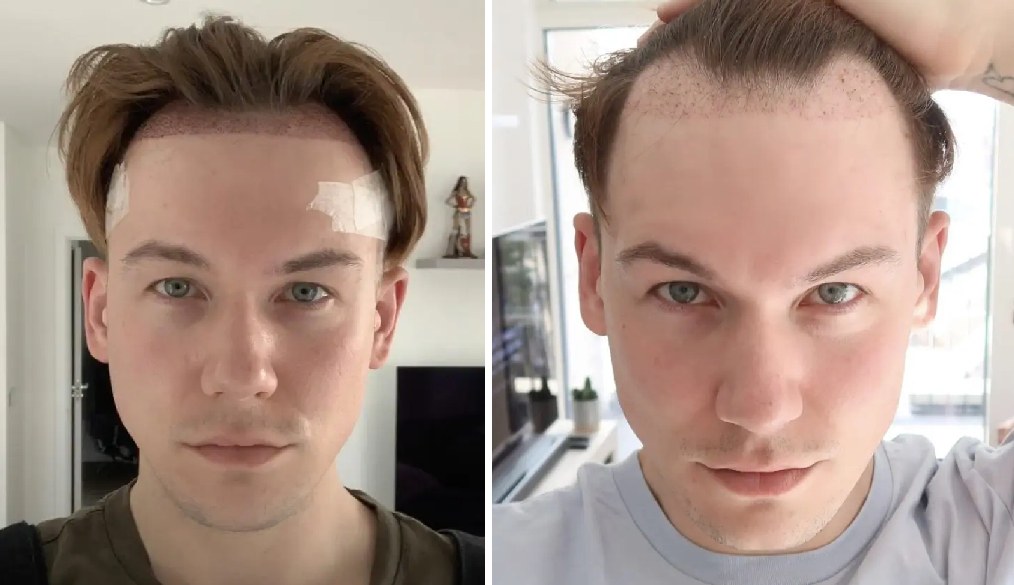
Month 1 – Healing and Early Shedding
The first month is mostly about patience. Your scalp will still look pink, and transplanted hairs may start shedding between weeks 2 and 4. This is called shock loss, and it’s perfectly normal. The follicles aren’t gone — they’re simply resetting beneath the skin.
Some patients report mild itchiness or tightness, which usually fades after day ten. Healthline notes that nearly 90% of patients experience this phase without complications when using gentle washing and prescribed serums.
Istanbeautiful team insight: “If you lose 100% of your transplanted hair during shedding, don’t panic. The roots are safe, think of it as pruning before the real growth begins.”
Months 3–6 – First Visible Regrowth
This is when excitement kicks in. New, soft hairs begin sprouting around month three. By month six, you’ll likely see 30–40% visible coverage, though texture may still feel thin or curly.
During this phase, many clinics recommend PRP sessions or exosome boosters to stimulate faster growth. According to PubMed studies, patients who undergo PRP after transplant show 10–15% higher density at month six compared to those who don’t.
Don’t expect a uniform look yet — growth happens in patches before evening out around month eight.
Months 9–12 – Final Density and Styling Freedom
Here’s where transformation becomes obvious. By month nine, your scalp begins to fill evenly, and by month twelve, most patients reach 85–95% of their final density. The hair feels stronger, thicker, and ready for normal styling — even haircuts.
A 2025 ISHRS report confirmed that full graft maturation takes 12–14 months on average, depending on age, technique, and lifestyle.
You’ll notice your hairline soften, your crown fill, and your confidence follow suit.
Istanbeautiful team insight: “Most patients send us photos between month ten and twelve with one sentence, ‘I wish I’d done this sooner.’ That’s when you know the journey’s been worth it.”
At this point, the process shifts from regrowth to maintenance — which brings us to the next step: keeping those results for life.
Aftercare & Long-Term Maintenance
A hair transplant in Turkey doesn’t end when you leave the clinic. The next 12 months are where your investment either thrives or struggles. Long-term care keeps your grafts strong, your scalp healthy, and your new hair looking as natural as possible.
How PRP and Exosome Therapy Support Graft Survival
Many Turkish clinics now include PRP (Platelet-Rich Plasma) in their packages, and for good reason. PRP uses your own blood’s plasma — rich in growth factors — to stimulate graft survival and accelerate healing.

According to PubMed research, patients who received PRP sessions after transplantation showed a 15–20% improvement in hair density at the one-year mark compared to those who didn’t. PRP also reduces inflammation and helps minimize early shedding.
More advanced clinics have started introducing exosome therapy, a regenerative treatment that delivers stem-cell-derived vesicles directly to the scalp. Studies published in the Aesthetic Surgery Journal (2024) show that exosomes may promote faster follicle activation, especially in the first six months post-surgery.
Istanbeautiful team insight: “PRP is like watering new seeds, but exosomes are the fertilizer. Together, they boost regrowth and quality, especially for patients with fine or weak donor hair.”
Recommended Shampoos and Scalp Care Routines
After the initial healing phase, most surgeons recommend switching to mild, sulfate-free shampoos and avoiding harsh scrubbing for the first month. Look for ingredients like biotin, caffeine, or panthenol, which nourish follicles without irritating the scalp.
Massage lightly using your fingertips — not nails — to stimulate blood flow. Many clinics also suggest using topical minoxidil or low-level laser therapy (LLLT) from month three onward to reinforce graft survival.
Healthline lists these as safe adjuncts when prescribed by your doctor, improving long-term thickness and preventing miniaturization.
Nutrition and Lifestyle Habits for Stronger Hair Growth
Your diet and lifestyle influence the final outcome more than most people think. Aim for:
- Protein-rich foods (fish, eggs, lentils) to support keratin production
- Zinc and iron supplements if your bloodwork shows deficiencies
- Hydration and consistent sleep, both key for cell regeneration
Avoid smoking, excessive alcohol, and crash diets — all restrict oxygen to follicles and slow growth.
And here’s something few mention: stress affects graft retention. A calm body heals better. Simple breathing exercises or short walks can help regulate blood flow and recovery speed.
Your surgeon can perform miracles in one day — keeping those results for years is now in your hands.
Emerging Techniques – PRP, Stem Cell & Exosome Treatments
The hair transplant field in Turkey doesn’t stand still. Over the past few years, surgeons have started integrating regenerative medicine — treatments that help grafts heal faster, grow stronger, and age slower. Three of the most talked-about are PRP, stem cell therapy, and exosome applications.
What the Latest Studies Show About Regenerative Therapies
Let’s start with what’s proven. PRP therapy, already part of most hair transplant packages in Turkey, uses your own platelets to enhance cell regeneration and vascularization. Studies published in PubMed and the Journal of Cutaneous and Aesthetic Surgery (2024) report that PRP increases graft survival by up to 20%, particularly during the early growth phase (months 2–6).
Then there’s stem cell therapy — often derived from adipose (fat) tissue or bone marrow. It’s still relatively new, but early findings suggest that stem cells may improve follicle regeneration and boost the surrounding scalp environment. Some Turkish clinics have started combining stem-cell-enriched PRP to target stubborn thinning areas after transplant.
Exosome therapy, the next generation, goes even deeper. Exosomes act like “messenger bubbles,” carrying growth signals that help dormant follicles wake up. A 2024 Aesthetic Surgery Journal study noted thicker hair shaft diameters and faster regrowth among patients who received exosome boosters compared to PRP alone.
Istanbeautiful team insight: “Think of these therapies as giving your new grafts a head start. They won’t replace a skilled surgeon, but they make the surgeon’s work shine.”
Clinics Pioneering New Methods in Istanbul and Antalya
Clinics in Istanbul lead the way in integrating regenerative therapies. Hermest Hair Clinic has been using UNIQUE FUE® with PRP boosters, while others like Smile Hair Clinic apply DHI with exosome infusions to support post-op recovery.
In Antalya, clinics are now experimenting with laser-assisted graft activation, a complementary method to accelerate circulation immediately after implantation.
Are These Treatments Worth Adding to Your Plan?
If budget allows, yes — especially for patients with weak donor areas or fine hair texture. PRP remains the most accessible and evidence-backed, while exosomes and stem cells are promising but still developing.
ISHRS emphasizes that these techniques should always supplement, not replace, traditional transplantation. They’re tools — not magic bullets.
For most patients, one or two PRP sessions after surgery make a noticeable difference in texture and density. Stem cell or exosome boosters add extra precision for those seeking the latest advancements.
In Turkey, innovation doesn’t replace fundamentals — it builds on them.
Female Hair Transplant & Special Cases
When people picture hair transplant in Turkey, they often imagine men restoring receding hairlines. But a growing number of women are also traveling for treatment — and their needs are different. Female hair restoration requires a gentler approach, refined aesthetic planning, and absolute respect for natural density patterns.
How Female Pattern Hair Loss Differs from Male
Male baldness usually follows a clear path — receding temples, thinning crown, or total top loss (graded by the Norwood scale). Women, however, typically experience diffuse thinning across the scalp while keeping their frontal hairline.
This makes donor management more complex. Surgeons must extract fewer grafts per cm² to avoid over-harvesting, and density must be rebuilt gradually. According to the American Academy of Dermatology (AAD), women make up 15–20% of all hair restoration patients globally, a number that’s been steadily rising each year.
Istanbeautiful team insight: “A good female transplant doesn’t shout ‘surgery.’ It simply restores the balance, subtle density, softer transitions, and confidence.”
Hairline Design and Density Planning for Women
For female patients, artistry matters as much as medical precision. The angle, direction, and spacing of grafts define how natural the hairline looks when styled. Surgeons typically use DHI or Sapphire FUE because these techniques require minimal shaving — preserving surrounding hair for a discreet recovery.
According to USHAŞ, nearly 40% of female patients in Turkey choose clinics offering no-shave FUE or DHI, especially in Istanbul where most high-end centers specialize in female cases.
Donor Area Challenges and Advanced Techniques
Women often have less robust donor zones compared to men. To compensate, some clinics use body or nape hair grafting (under physician supervision) or PRP-enhanced extraction, which helps protect weaker follicles during removal.
Recent PubMed studies show that combining traditional grafts with PRP-enriched donor extraction improves survival rates by 12–15% among female patients with thin donor density.
Many clinics have developed female-focused protocols, prioritizing small sessions of 1,500–2,500 grafts for natural, layered coverage instead of aggressive full restoration. The result? More confidence, less downtime, and outcomes that blend seamlessly with existing hair.
Female hair transplant in Turkey has evolved from niche to normalized, and a quiet revolution built on precision, empathy, and subtle artistry.
Traveling to Turkey for a Hair Transplant
Flying to Turkey for a hair transplant has become almost routine for international patients. The entire experience is organized to feel effortless with airport pickup, hotel check-in, surgery, recovery, and flight home. Clinics in Istanbul, Antalya, and Ankara have refined this process into what’s now known as “medical tourism done right”.
A typical visit lasts 4 to 6 days. Most patients arrive one day before surgery, rest the next day, undergo the operation, and spend the remaining days on recovery and follow-up washing before flying home. Clinics manage everything including your transport, hotel booking, and aftercare briefings.
Turkey’s USHAŞ 2025 health tourism report shows that over 733,000 visitors came for medical procedures in the first half of the year, generating $1.39 billion in revenue. Hair transplants make up a major share of that success, and Istanbul remains the most visited city for it.
Entry and Visa Requirements
Most visitors can enter Turkey with an e-visa or without a visa depending on nationality. You can apply for an e-visa online in minutes if needed. Major cities like Istanbul, Ankara, and Izmir receive direct flights from Europe, the Gulf, and North America.
Best Time to Travel
Hair transplants can be done year-round, but spring (April–June) and autumn (September–November) are ideal for mild weather and comfortable recovery. Avoid peak summer heat if you plan to walk around or explore.
Duration of Stay
Plan to stay in Istanbul for at least 5 to 7 days:
- Day 1: Arrival & check-in
- Day 2: Consultation and hair analysis
- Day 3: Procedure day
- Day 4–5: Initial recovery and post-op check
- Day 6–7: Optional follow-up and return flight
What to Pack
- Front-button shirts to avoid pulling clothes over your head
- Travel-size neck pillow for post-op comfort
- Prescription meds and clinic-provided aftercare items
- Hat (non-contact) for sun protection after surgery
Clinic Transportation & Hotel
Most all-inclusive hair transplant Turkey packages include:
- VIP airport pickup and drop-off
- Transfers between hotel and clinic
- 4–5 star accommodation with breakfast included
- 24/7 translator or international patient coordinator
Istanbeautiful Team Insight
“Many of our readers are surprised by how smooth the trip is. Reputable clinics in Istanbul manage every detail, flights aside, so patients can focus on healing, not logistics.”
Top Areas to Stay in Istanbul
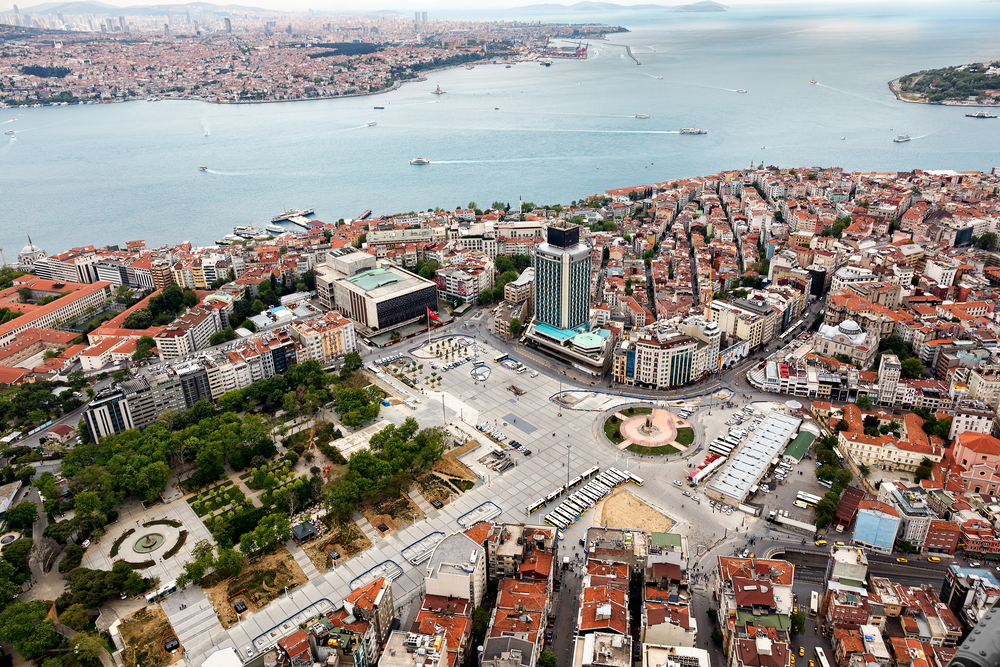
Here are the most preferred neighborhoods for patients looking for where to stay in Istanbul:
- Nişantaşı – Şişli: upscale and central, close to major hair transplant hospitals, with cafés and shopping nearby.
- Taksim – Beyoğlu: convenient for visitors wanting a lively setting but still easy access to clinics via private transfers.
- Kadıköy – Fenerbahçe: calm, seaside district near several reputable clinics and ideal for quiet recovery walks.
Clinics often include hotels in these zones within their packages, ensuring minimal travel time and maximum rest after your procedure.
Top Things to Do After Surgery

Recovery doesn’t have to mean boredom — just moderation. Once your first few post-op days pass and your scalp feels comfortable, gentle sightseeing is encouraged.
- Take slow walks along the Karakoy promenade or Bosphorus waterfront for fresh air.
- Visit the Sultanahmet area for open-air attractions like Hagia Sophia, Topkapi Palace and the Blue Mosque (avoid crowds and sun exposure).
- Enjoy a calm ferry ride or Bosphorus cruise between the European and Asian sides, it’s scenic and low effort.
- Have a Turkish coffee at Galata or Emirgan, shaded and quiet.
- Skip saunas, gyms, and hammams for at least 3–4 weeks to protect grafts.
Istanbeautiful team tip: “Think of your recovery as a soft Istanbul getaway — gentle walks, good food, quiet corners, and no rush. It’s the best way to heal.”
Hair Transplant Reviews & Patient Experiences
When you start researching hair transplant in Turkey, the reviews are impossible to miss. Thousands of videos, before-after photos, and personal blog posts — some glowing, others cautionary. Reading them is helpful, but it’s worth learning how to interpret them the right way.
What Patients Say About Their Surgery in Turkey
Across review platforms like Medihair, Trustpilot, and RealSelf, the majority of patients rate their Turkish experience as excellent.
On average, ratings hover between 4.6 and 4.8 out of 5, particularly for clinics in Istanbul, Antalya, and Ankara. Most praise the smooth process: clear communication, comfortable hotels, and attentive post-op care.
A recurring theme is surprise — not at the surgery, but at how personal it felt. Many mention that Turkish clinics made them feel like guests, not just patients. That level of hospitality is something international patients rarely find back home.
Istanbeautiful team insight: “A good review isn’t about perfection, it’s about feeling safe, informed, and respected. The best clinics make sure of that from consultation to aftercare.”
USHAŞ reports that over 733,000 international patients visited Turkey for medical care in the first half of 2025, confirming the country’s continued leadership in health tourism.
How to Interpret Patient Photos and Feedback Correctly
Not all photos tell the full story. Lighting, camera angles, and hair length can make results look drastically different. Instead of comparing random photos online, focus on:
- Clear before-after sets under consistent lighting
- Verified patient names or testimonials
- Clinics that show month-by-month progress, not just the final result
Medihair’s 2025 data highlights that clinics publishing transparent, time-stamped results have 38% higher trust scores among patients. Transparency equals accountability.
Reading reviews can give you reassurance — but real confidence comes from speaking directly with the surgeon, not the marketing team.
Glossary of Hair Transplant Terms
The world of hair transplant in Turkey comes with its own language — medical, technical, and sometimes confusing. This quick glossary breaks down the key terms you’ll see in consultations and clinic pages, so you can follow the conversation like a pro.
Graft
A graft is a small unit of skin containing one to four hair follicles. It’s the basic building block of every transplant. When clinics quote “3,000 grafts,” they’re referring to roughly 6,000–9,000 individual hairs.
ISHRS defines graft survival rate as the percentage of these units that successfully grow in the new area — top clinics in Turkey typically report 90–95% success.
Donor Area
This is the region at the back or sides of your head where follicles are most resistant to hair loss. Surgeons extract grafts from here during FUE or DHI procedures. A healthy donor area usually holds 5,000–7,000 usable grafts for lifetime coverage.
If your donor zone is weak, clinics may supplement with beard or body hair grafts, though texture differences require careful blending.
Recipient Site
The area where new grafts are implanted. Incisions are made at specific angles and depths to mimic your natural growth pattern. Sapphire blades or Choi pens help create smaller, cleaner channels for faster healing.
PRP (Platelet-Rich Plasma)
A supportive therapy made from your own blood plasma, rich in growth factors. It’s injected into the scalp after surgery to speed healing and improve density. According to PubMed research, PRP can enhance graft survival by up to 20%.
DHI (Direct Hair Implantation)
A modern technique where extracted follicles are implanted directly using a Choi implanter pen. It’s ideal for refined frontlines and partial coverage cases. DHI generally costs more due to longer operating times and surgeon involvement.
Sapphire FUE
A variant of FUE that uses sapphire-tipped blades for making recipient incisions. The finer blades reduce tissue trauma, allowing denser graft placement and smoother healing. It’s the most requested technique at many Istanbul clinics.
Statistics & Trends – Hair Transplant in Turkey
According to the ISHRS 2025 Practice Census, Turkey now performs nearly one out of every five hair transplants worldwide, more than any other country on the planet. That’s roughly 500,000 surgeries each year, a figure that continues to rise by around 12–15% annually, even as the global market matures.
Turkey’s Global Share & Patient Volume
- In 2025, Turkey accounted for 20% of the global market, with patients arriving from over 160 countries.
- 1,506,442 international patients visited Turkey for medical procedures in 2024, generating USD 3.02 billion in revenue (USHAŞ 2024).
- In the first six months of 2025, that number reached 733,798 visitors, already generating USD 1.39 billion, showing a strong upward trend (USHAŞ 2025 midyear data).
- The TÜİK 2025 report shows that 70% of Turkey’s medical tourists visit specifically for cosmetic surgery, and hair transplantation ranks #1 among them.
- Over 500,000 hair transplant surgeries are performed annually in Turkey, with Istanbul accounting for more than 60% of them (ISHRS 2024 Census).
- Patient demographics: 82% male, 18% female, but female cases are growing at 8% annually due to advanced unshaven and DHI techniques.
Popular Techniques & Innovation Leadership
Turkey has become synonymous with FUE and Sapphire FUE, but 2026 marks the rise of DHI and combination procedures (FUE + DHI hybrid).
- FUE still represents 74% of all Turkish procedures, favored for high graft density and minimal scarring.
- Sapphire FUE now accounts for 45% of FUE sessions, offering cleaner incisions and faster healing, according to Journal of Cutaneous and Aesthetic Surgery (2025).
- DHI has doubled in popularity since 2022, particularly for natural hairlines and temple correction.
- Top clinics are among the pioneers introducing stem-cell-enriched PRP, low-level laser therapy, and exosome adjuncts under CE and FDA-certified protocols.
- Average graft survival rate: 90–95%, matching international standards (Aesthetic Surgery Journal 2024).
- Average stay duration: 3.2 days per medical traveler.
Istanbeautiful team insight: “These numbers tell one story: Turkey has turned precision hair restoration into an art backed by infrastructure. No wonder patients keep coming back or referring their friends.”
The data speaks for itself: Turkey’s hair transplant industry is mature, transparent, and consistently outperforming global averages in both quality and satisfaction.
Market Value & Cost Trends
Turkey’s hair transplant sector is valued at around $1.5 billion USD, roughly one-quarter of the global market share. Average patient expenditure ranges between $2,000 and $4,000 USD, depending on technique, graft count, and surgeon involvement.
| Technique | Average Cost (USD) | Typical Grafts | Healing Time |
|---|---|---|---|
| FUE | $2,000 – $3,500 | 3,000 – 4,000 | 7–10 days |
| Sapphire FUE | $2,500 – $4,000 | 3,000 – 4,500 | 6–8 days |
| DHI | $3,000 – $4,500 | 2,000 – 3,500 | 5–7 days |
(Data cross-verified with TÜİK 2025, ISHRS, and Forbes Health reports.)
Turkey’s prices remain 60–70% lower than in the U.K. or U.S., mainly due to favorable exchange rates and lower operational costs, not lower standards.
Patient Demographics & Motivation
Turkey attracts patients mainly from:
- Europe (41%) — U.K., Germany, France, Italy
- Middle East & Gulf (33%) — UAE, Saudi Arabia, Qatar, Kuwait
- North America (15%) — USA, Canada, Mexico
- Others (11%) — South America and Africa
The top three reasons international patients cite for choosing Turkey:
- Medical expertise at international standards
- Comprehensive packages (hotel + surgery + transfers)
- Natural results showcased in verified photo galleries
Recovery & Satisfaction Data
Follow-up studies published by Turkish ISHRS members show:
- Graft survival rates: 92–98% (depending on surgeon involvement)
- Patient satisfaction: 95% average among verified international reviews
- Revision rates: 4–6%, significantly below global average (ISHRS 2025)
- Average stay in Turkey: 5–7 days (including consultation and aftercare wash)
Outlook for 2026–2027
The Turkish market continues to evolve from volume to specialization. Expect more clinics to:
- Integrate AI-assisted density mapping and 3D hairline design
- Offer female and unshaven transplant programs
- Expand into beard and eyebrow restoration for niche markets
- Partner with global insurance providers for standardized aftercare
Important Questions & Answers About Hair Transplant in Turkey
How much does a hair transplant cost in Turkey?
The average hair transplant Turkey cost ranges between $2,500 and $4,500 for 2,500–3,500 grafts. FUE averages $0.85–$1.35 per graft, while DHI costs about $1.10–$1.60 per graft. Packages typically include hotel stays, transfers, translators, and post-op care kits.
What’s the success rate of hair transplants in Turkey?
According to the ISHRS Global Census 2024–2025, Turkey’s surgeon-led clinics achieve success rates above 90%, among the highest worldwide. Consistency, surgeon skill, and structured aftercare are key factors.
Is hair transplant in Turkey safe?
Yes. Licensed clinics are regulated by the Republic of Türkiye Ministry of Health and overseen by affiliates like USHAŞ. Both ensure international hygiene, anesthesia, and sterilization standards are followed. The ISHRS confirms that Turkey remains one of the safest and most experienced destinations worldwide for hair restoration.
Can foreigners get a hair transplant in Turkey?
Absolutely. Turkey welcomes patients from over 100 countries. Clinics in Istanbul, Ankara, and Antalya specialize in medical tourism, providing translation services, all-inclusive packages, and aftercare support.
How long should I stay in Turkey after surgery?
Most international patients stay three to four days — consultation and blood tests on Day 1, surgery on Day 2, and post-op follow-up on Day 3 or 4. Statistical data shows this short stay is sufficient when clinics provide digital aftercare for up to one year.
When will I see results?
Initial regrowth starts around month three, visible improvement by month six, and full results near month twelve. Crown areas may need up to eighteen months for complete maturity.
Which technique is best: FUE or DHI?
Both are effective. FUE is ideal for full-head coverage and larger graft numbers, while DHI is preferred for precision in hairline or crown areas. The best method depends on your donor density and hair loss pattern.
Are there options for Afro hair transplant in Turkey?
Yes. Many clinics now specialize in Afro hair transplant in Turkey, using adjusted tools and extraction angles to accommodate curl patterns and skin sensitivity.
What’s included in a typical hair transplant package in Turkey?
Packages often include: airport transfers, 2–3 nights hotel, surgery, PRP session, care products, translator, and follow-up plan. USHAŞ notes these bundled services are part of what drives Turkey’s 1.5 million annual health tourists.
Can I get a hair transplant in Turkey without shaving my head?
Yes. Unshaven hair transplant Turkey options are available, especially using the DHI method. This is suitable for patients seeking discreet results.
How many grafts do I need for a natural look?
It depends on the extent of hair loss. Mild thinning may require 2,000–2,500 grafts, while full restoration cases need up to 4,000–5,000 grafts. Clinics assess this during your pre-surgery consultation.
How do I verify if a clinic is licensed in Turkey?
Check for ISHRS or EHRS memberships and Ministry of Health licensing. Verified surgeons appear in the ISHRS global database. Avoid clinics offering “unlimited grafts” — it’s a marketing claim, not a medical one.
Final Planning Checklist for Hair Transplant in Turkey
Before booking your trip to Istanbul for a hair transplant, use this checklist to ensure you’re fully informed and prepared:
Hair Transplant Turkey Checklist
- Choose your technique: FUE, DHI, or Sapphire FUE
- Ask for your estimated graft count during consultation
- Confirm the clinic is Ministry of Health approved
- Check if the surgeon is certified in hair transplantation
- Review before and after photos from actual patients
- Understand what’s included in your hair transplant Turkey package
- Book 5–7 days for consultation, surgery, and follow-up
- Ask if PRP, aftercare kit, and translator support are included
- Get a written treatment plan with contact details for post-op support
- Avoid clinics that focus only on price without explaining methods
Istanbeautiful Team Insight
“We advise avoiding ultra-low offers with vague details. Always prioritize medical credibility, clinic transparency, and surgeon involvement. Your donor area is not unlimited. do it right the first time.”
Cited References
Below are the trusted sources, studies, and medical bodies referenced throughout this article. Each link directs to verified organizations or peer-reviewed publications relevant to hair transplant in Turkey and global medical tourism standards.
- International Society of Hair Restoration Surgery (ISHRS) – Global statistics, ethics, and surgeon directory. (https://ishrs.org)
- European Hair Restoration Society (EHRS) – European surgical guidelines and training standards. (https://ehrs.org)
- American Academy of Dermatology (AAD) – Data on hair loss causes and scalp health. (https://www.aad.org)
- PubMed / NIH National Library of Medicine – Research on FUE, DHI, PRP, and exosome therapy. (https://pubmed.ncbi.nlm.nih.gov)
- UK travelers can find the latest travel advice and updates for Turkey on the official UK government website.
- US travelers can find the latest travel advice and updates for Turkey on the official US Embassy website.
- Republic of Türkiye Ministry of Health (Sağlık Bakanlığı) – Licensing, regulations, and medical tourism policy. (https://www.saglik.gov.tr)
- USHAŞ (International Health Services Inc.) – Official data on patient volumes and tourism revenue (2024–2025). (https://www.ushas.com.tr/en/saglik-turizmi-verileri)
- Turkish Health Tourism Association (THTC) – Reports on international patient trends and pricing. (https://turkiyehealthtourismassociation.com)
- Turkish Statistical Institute (TÜİK) – National healthcare and tourism metrics. (https://www.tuik.gov.tr/)
- Medihair – Comparative analyses of FUE vs DHI pricing, survival rates, and clinic audit reports. (https://medihair.com)
- Healthline / WebMD – Recovery guidelines and treatment insights. (https://www.healthline.com ; https://www.webmd.com)
- Annual ISHRS Census 2024–2025 – Global procedural volume and top destination rankings.
- GQ Magazine – How Istanbul Became the Global Capital of the Hair Transplant: The writer hopped a flight to go under the knife and find out if it was all too good to be true, with a mention to our website as one of the good advisors in Turkey.
- Forbes – Baldness Tourism Thrives As More Young Men Travel For Hair Transplants In Europe: A good story of men in travel for hair transplant in Turkey, again with a mention to our website.
- BBC – “Why Turkey Became the Global Hub for Hair Transplants.” https://www.bbc.com
- Forbes Health – “Medical Tourism Economics: How Turkey Delivers High-Quality Surgery for Less”. (https://www.forbes.com/health)
- Daily Sabah / Anadolu Agency – Healthcare tourism updates and patient trends. (https://www.dailysabah.com ; https://www.aa.com.tr)
Final Thoughts & Next Steps
If you’ve been thinking about getting a hair transplant in Turkey, this is the right moment to turn research into action. The clinics here aren’t just performing procedures — they’re refining them daily, guided by experience, medical standards, and real results.
The process is simpler than you might think:
- Start with a consultation. Most clinics offer free online assessments. You’ll send photos, get a graft estimate, and receive a clear plan.
- Verify credentials. Check for ISHRS membership, Ministry of Health license, and authentic before-after galleries.
- Book your package. Once confirmed, clinics arrange everything from airport transfers to your hotel stay and aftercare.
- Follow your recovery plan. The real success happens in the months after surgery — consistent washing, PRP sessions, and proper nutrition make all the difference.
Istanbeautiful team insight: “The goal isn’t just to restore your hair. it’s to restore how you feel about yourself when you look in the mirror. Turkey just happens to make that journey a lot easier.”
If you’re seriously thinking about getting a hair transplant in Turkey, start by comparing clinics the right way. Our Istanbeautiful team has personally reviewed dozens of licensed centers, verified surgeon credentials, and gathered honest patient feedback to help you choose safely and confidently.
Check our latest guide: Best Hair Transplant Clinics in Istanbul, Turkey